New Zealand Cities: A Comprehensive Guide to the Best Urban Areas in the Land of the Long White Cloud
New Zealand is a beautiful country with a diverse range of cities, each offering its own unique character and charm. From the bustling metropolis of Auckland to the laid-back vibe of Wellington, there is something for everyone. In this article, we will take a closer look at the major cities in New Zealand, as well as some of the smaller towns and districts that make this country so special.
New Zealand’s major cities are known for their stunning natural beauty, vibrant culture, and world-class dining and entertainment. Auckland, the largest city in the country, is a hub of activity, with a bustling waterfront, world-renowned museums, and a thriving nightlife. Wellington, the capital city, is known for its creative flair and bohemian vibe, with a thriving arts scene and a plethora of quirky cafes and bars. Other major cities include Christchurch, Dunedin, and Hamilton, each with their own unique character and charm.
Key Takeaways
- New Zealand offers a diverse range of cities, each with its own unique character and charm.
- The major cities in New Zealand are known for their stunning natural beauty, vibrant culture, and world-class dining and entertainment.
- Wellington is the capital city and is known for its creative flair and bohemian vibe.
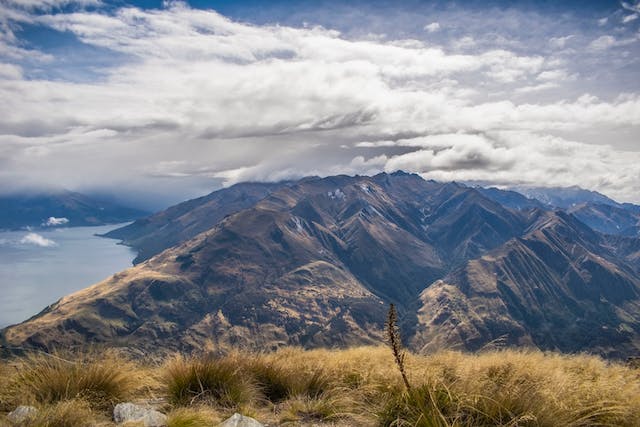
Overview of New Zealand Cities
New Zealand is a country located in the southwestern Pacific Ocean. It is made up of two main islands, the North Island and the South Island, as well as numerous smaller islands. The country has a total population of approximately 5 million people, with the majority living in urban areas.
New Zealand’s largest city is Auckland, which is located on the North Island. Auckland has a population of around 1.7 million people and is known for its bustling city center, beautiful beaches, and diverse cultural offerings. Other major cities on the North Island include Wellington, the country’s capital, and Hamilton, a growing city with a strong economy.
On the South Island, the largest city is Christchurch, which has a population of around 400,000 people. Christchurch is known for its stunning natural scenery, including the nearby Southern Alps, as well as its vibrant arts and culture scene. Other major cities on the South Island include Dunedin, a historic university town, and Nelson, a popular tourist destination known for its sunny climate and beautiful beaches.
In addition to these larger cities, New Zealand is also home to many smaller towns and communities, each with its own unique character and charm. These towns range from quiet coastal villages to bustling rural centers, and offer visitors a chance to experience the country’s diverse landscapes and cultures.
Overall, New Zealand’s cities and towns offer a wide range of experiences for visitors and residents alike, from modern urban centers to quaint rural communities. With a rich history, stunning natural scenery, and a vibrant culture, New Zealand is truly a unique and fascinating place to explore.
Major Cities in New Zealand
New Zealand has several major cities, each with its unique features and attractions. Here are some of the major cities in New Zealand:
Auckland
Auckland is the largest city in New Zealand, with a population of over 1.6 million people. It is located in the North Island and is known for its stunning natural beauty, including the Hauraki Gulf and the Waitakere Ranges. Auckland is also home to the Sky Tower, which is the tallest freestanding structure in the Southern Hemisphere.
Wellington
Wellington is the capital city of New Zealand and is located in the southern part of the North Island. It has a population of around 400,000 people and is known for its vibrant culture, scenic waterfront, and stunning natural beauty. Wellington is also home to the Te Papa Tongarewa museum, which is the national museum of New Zealand.
Christchurch
Christchurch is the largest city in the South Island and has a population of around 380,000 people. It is known for its stunning gardens, including the Christchurch Botanic Gardens, and its unique architecture, including the Cardboard Cathedral. Christchurch is also home to the International Antarctic Centre, which is a popular tourist attraction.
Dunedin
Dunedin is located in the southern part of the South Island and has a population of around 130,000 people. It is known for its Scottish heritage, stunning architecture, and beautiful natural scenery. Dunedin is also home to the University of Otago, which is the oldest university in New Zealand.
Hamilton
Hamilton is located in the Waikato region of the North Island and has a population of around 170,000 people. It is known for its stunning gardens, including the Hamilton Gardens, and its vibrant nightlife. Hamilton is also home to the Waikato Museum, which showcases the history and culture of the region.
Tauranga
Tauranga is located in the Bay of Plenty region of the North Island and has a population of around 150,000 people. It is known for its stunning beaches, including Mount Maunganui Beach, and its vibrant arts and culture scene. Tauranga is also home to the Tauranga Art Gallery, which showcases the work of local artists.
Napier
Napier is located in the Hawke’s Bay region of the North Island and has a population of around 63,000 people. It is known for its stunning art deco architecture, beautiful beaches, and world-renowned wineries. Napier is also home to the National Aquarium of New Zealand, which showcases the marine life of the region.
Hastings
Hastings is located in the Hawke’s Bay region of the North Island and has a population of around 75,000 people. It is known for its stunning gardens, including the Hawke’s Bay Regional Botanic Gardens, and its vibrant arts and culture scene. Hastings is also home to the Hastings City Art Gallery, which showcases the work of local artists.
Palmerston North
Palmerston North is located in the Manawatu-Wanganui region of the North Island and has a population of around 90,000 people. It is known for its stunning parks and gardens, including the Victoria Esplanade Gardens, and its vibrant arts and culture scene. Palmerston North is also home to the New Zealand Rugby Museum, which showcases the history of rugby in New Zealand.
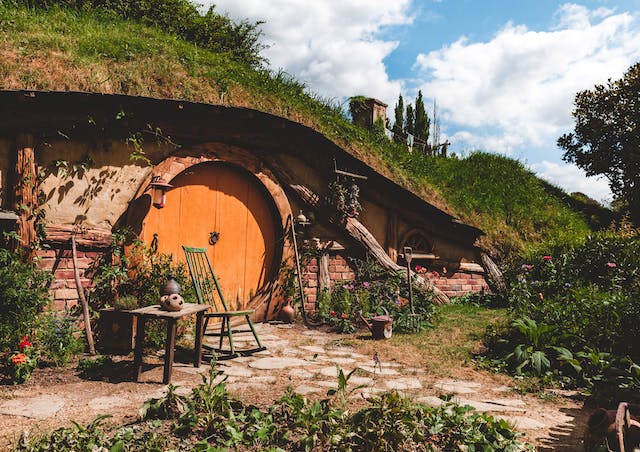
New Plymouth
New Plymouth is located in the Taranaki region of the North Island and has a population of around 80,000 people. It is known for its stunning natural beauty, including the Mount Taranaki volcano and the Coastal Walkway, and its vibrant arts and culture scene. New Plymouth is also home to the Govett-Brewster Art Gallery, which showcases contemporary art from New Zealand and around the world.
Nelson
Nelson is located in the Tasman region of the South Island and has a population of around 52,000 people. It is known for its stunning natural beauty, including the Abel Tasman National Park and the Nelson Lakes National Park, and its vibrant arts and culture scene. Nelson is also home to the Suter Art Gallery, which showcases the work of local artists.
Rotorua
Rotorua is located in the Bay of Plenty region of the North Island and has a population of around 70,000 people. It is known for its stunning natural beauty, including the geothermal activity in the area, and its vibrant Maori culture. Rotorua is also home to the Rotorua Museum, which showcases the history and culture of the region.
Regions and Districts
New Zealand is divided into 16 regions, each with its own unique character and highlights. These regions are further divided into districts, which are governed by local government and overseen by regional councils. Here are some of the top regions and districts to visit in New Zealand:
Canterbury
Canterbury is located in the central-eastern part of the South Island and is home to the city of Christchurch. Visitors can explore the city’s vibrant arts scene, historic architecture, and beautiful parks. The region is also known for its stunning natural beauty, including the Canterbury Plains, the Southern Alps, and the coastal town of Akaroa.
Otago
Otago is located in the southeastern part of the South Island and is known for its rugged landscapes and rich history. Visitors can explore the historic gold rush town of Arrowtown, take a scenic drive through the Central Otago wine region, or hit the slopes at one of the region’s many ski resorts.
Waikato
Waikato is located in the central part of the North Island and is known for its beautiful countryside, underground caves, and vibrant Maori culture. Visitors can explore the Waitomo Caves, go hiking in the Coromandel Peninsula, or visit the iconic Hobbiton movie set.
Bay of Plenty
The Bay of Plenty is located in the northeastern part of the North Island and is known for its stunning beaches, warm climate, and abundance of outdoor activities. Visitors can go surfing in Mount Maunganui, visit the active White Island volcano, or explore the stunning Kaimai Mamaku Forest Park.
Taranaki
Taranaki is located on the west coast of the North Island and is known for its stunning mountain, rugged coastline, and vibrant arts scene. Visitors can hike to the summit of Mount Taranaki, explore the coastal town of New Plymouth, or visit the Len Lye Centre, a museum dedicated to the work of the famous New Zealand artist.
Northland
Northland is located in the northern part of the North Island and is known for its rich Maori history, beautiful beaches, and subtropical climate. Visitors can explore the Waitangi Treaty Grounds, go sandboarding at the Te Paki Sand Dunes, or visit the historic town of Russell.
Southland
Southland is located in the southern part of the South Island and is known for its stunning natural beauty, including the Fiordland National Park and the Milford Sound. Visitors can go hiking in the Catlins Forest Park, visit the historic town of Invercargill, or take a scenic drive along the Southern Scenic Route.
Marlborough
Marlborough is located in the northeastern part of the South Island and is known for its world-renowned wine region and stunning coastal landscapes. Visitors can go wine tasting in the town of Blenheim, take a scenic flight over the Marlborough Sounds, or go hiking in the Queen Charlotte Track.
West Coast
The West Coast is located on the west coast of the South Island and is known for its rugged landscapes, glaciers, and gold rush history. Visitors can explore the Franz Josef Glacier, go hiking in the Paparoa National Park, or visit the historic town of Hokitika.
Hawke’s Bay
Hawke’s Bay is located in the eastern part of the North Island and is known for its sunny climate, world-renowned wine region, and stunning Art Deco architecture. Visitors can go wine tasting in the town of Napier, explore the Te Mata Peak hiking trail, or visit the National Aquarium of New Zealand.
Tasman
Tasman is located in the northwestern part of the South Island and is known for its stunning coastal landscapes and outdoor activities. Visitors can go hiking in the Abel Tasman National Park, visit the iconic Split Apple Rock, or go kayaking in the Golden Bay.
Gisborne
Gisborne is located in the eastern part of the North Island and is known for its stunning beaches, rich Maori history, and world-renowned wine region. Visitors can go wine tasting in the town of Gisborne, visit the Tairawhiti Museum, or go surfing at the famous Wainui Beach.
Overall, New Zealand’s regions and districts offer a diverse range of experiences for visitors to explore. From stunning natural landscapes to vibrant cities and cultural experiences, there is something for everyone in this beautiful country.
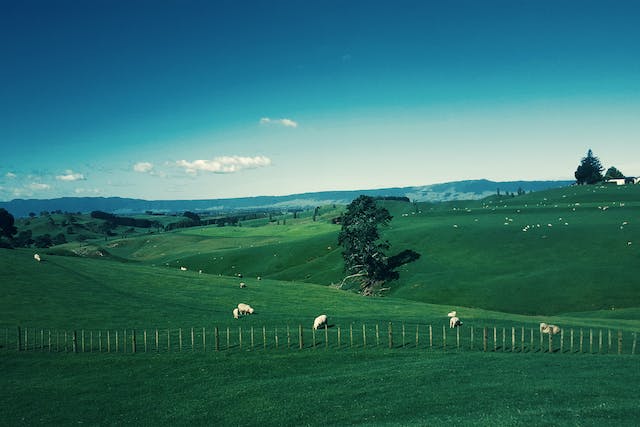
Smaller Cities and Towns
New Zealand is known for its stunning natural beauty, but it’s not just the big cities that are worth visiting. The smaller cities and towns offer a unique charm and character that can’t be found anywhere else. Here are some of the smaller cities and towns that are worth checking out:
Whanganui
Whanganui is a town located on the west coast of the North Island. It’s known for its beautiful river and historic architecture. Visitors can take a walk along the river, explore the town’s many art galleries, or visit the iconic Durie Hill Elevator.
Invercargill
Invercargill is the southernmost city in New Zealand and is known for its Scottish heritage. Visitors can explore the city’s many parks and gardens, visit the Southland Museum and Art Gallery, or take a trip to the nearby Bluff to try some of the famous Bluff oysters.
Whangārei
Whangārei is a city located in the Northland region of the North Island. It’s known for its beautiful beaches and subtropical climate. Visitors can take a trip to the nearby Poor Knights Islands, explore the Whangārei Falls, or visit the Whangārei Art Museum.
Queenstown
Queenstown is a popular tourist destination located in the South Island. It’s known for its stunning scenery and adventure activities, such as skiing, bungee jumping, and skydiving. Visitors can also take a trip to nearby Milford Sound, go wine tasting in the nearby Central Otago region, or take a scenic helicopter flight over the mountains.
Timaru
Timaru is a town located on the east coast of the South Island. It’s known for its beautiful beaches and historic architecture. Visitors can take a walk along Caroline Bay, visit the Aigantighe Art Gallery, or take a trip to the nearby Mount John Observatory.
Blenheim
Blenheim is a town located in the Marlborough region of the South Island. It’s known for its wine industry and beautiful vineyards. Visitors can take a wine tour, go hiking in the nearby Marlborough Sounds, or visit the Omaka Aviation Heritage Centre.
Greymouth
Greymouth is a town located on the west coast of the South Island. It’s known for its rugged coastline and gold mining history. Visitors can take a walk along the beach, visit the nearby Shantytown Heritage Park, or take a scenic train ride on the TranzAlpine.
Westport
Westport is a town located on the west coast of the South Island. It’s known for its beautiful beaches and outdoor activities, such as hiking and surfing. Visitors can take a trip to the nearby Denniston Plateau, visit the Coaltown Museum, or take a scenic drive along the Great Coast Road.
Masterton
Masterton is a town located in the Wairarapa region of the North Island. It’s known for its beautiful countryside and outdoor activities, such as hiking and cycling. Visitors can take a trip to the nearby Pukaha Mount Bruce National Wildlife Centre, visit the Aratoi Wairarapa Museum of Art and History, or go wine tasting in the nearby Martinborough region.
Levin
Levin is a town located in the Horowhenua region of the North Island. It’s known for its beautiful gardens and outdoor activities, such as hiking and fishing. Visitors can take a trip to the nearby Tararua Range, visit the nearby Owlcatraz Native Bird and Wildlife Park, or take a scenic drive along the Kapiti Coast.
Richmond
Richmond is a town located in the Tasman region of the South Island. It’s known for its beautiful beaches and outdoor activities, such as hiking and cycling. Visitors can take a trip to the nearby Abel Tasman National Park, visit the nearby World of WearableArt and Classic Cars Museum, or go wine tasting in the nearby Nelson region.
Havelock North
Havelock North is a town located in the Hawke’s Bay region of the North Island. It’s known for its beautiful countryside and outdoor activities, such as hiking and cycling. Visitors can take a trip to the nearby Te Mata Peak, visit the nearby Cape Kidnappers, or go wine tasting in the nearby Hawke’s Bay region.
Mosgiel
Mosgiel is a town located in the Otago region of the South Island. It’s known for its beautiful countryside and outdoor activities, such as hiking and fishing. Visitors can take a trip to the nearby Taieri Gorge Railway, visit the nearby Orokonui Ecosanctuary, or take a scenic drive along the Otago Peninsula.
Kaiapoi
Kaiapoi is a town located in the Canterbury region of the South Island. It’s known for its beautiful riverside location and
Unique Aspects of New Zealand Cities
New Zealand cities offer a unique blend of adventure, relaxation, and natural beauty. Here are some of the most notable aspects that set them apart:
Adventure
New Zealand is known as the adventure capital of the world, and its cities are no exception. Auckland, for example, offers a range of thrilling activities such as bungy jumping, skydiving, and jet boating. Queenstown is another popular destination for adventure seekers, with activities like skiing, snowboarding, and mountain biking.
Relaxation
While adventure is a big draw for many visitors, New Zealand cities also offer plenty of opportunities for relaxation. Wellington, for example, has a thriving cafe culture and is known for its laid-back vibe. Christchurch is another city that’s great for unwinding, with its tranquil parks and gardens.
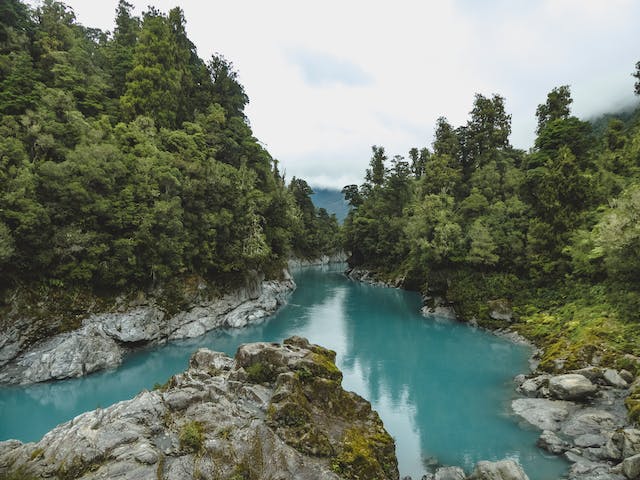
Parks
New Zealand is home to some of the most beautiful parks in the world, and its cities are no exception. Auckland’s Cornwall Park is a popular spot for picnics and walks, while Wellington’s Botanic Garden is a tranquil oasis in the heart of the city. Christchurch’s Hagley Park is also worth a visit, with its sprawling lawns and picturesque lake.
Earthquakes
New Zealand sits on the boundary of two tectonic plates, which makes it prone to earthquakes. While this can be a concern for some visitors, it’s also an opportunity to learn about the science behind earthquakes and how they shape the landscape. Christchurch, in particular, has been affected by several major earthquakes in recent years, and visitors can see the ongoing rebuilding efforts firsthand.
Penguins
New Zealand is home to several species of penguins, and visitors to the country’s cities can often see them up close. Dunedin, in particular, is known for its penguin colonies, and visitors can take guided tours to see the birds in their natural habitat.
European
New Zealand has a rich European heritage, and this is reflected in its cities’ architecture and culture. Wellington’s historic buildings and museums offer a glimpse into the country’s colonial past, while Dunedin’s Scottish heritage is evident in its street names and landmarks.
Aotearoa
Finally, New Zealand’s Maori heritage is an important part of its identity, and visitors to the country’s cities can learn about Maori culture through museums, art galleries, and cultural experiences. Auckland’s War Memorial Museum, for example, has a large collection of Maori artifacts, while Rotorua is known for its Maori cultural shows and geothermal attractions.
Frequently Asked Questions
What are the top 3 major cities in New Zealand?
The top 3 major cities in New Zealand are Auckland, Wellington, and Christchurch. Auckland is the largest city in New Zealand, while Wellington is the capital city.
How many cities are there in New Zealand?
There are 16 cities in New Zealand, including Auckland, Wellington, and Christchurch.
What are the two major cities in New Zealand called?
The two major cities in New Zealand are Auckland and Wellington. Auckland is the largest city in New Zealand, while Wellington is the capital city.
What is the main city of New Zealand?
Auckland is considered the main city of New Zealand. It is the largest city in New Zealand and is home to a significant portion of the country’s population.
Is New Zealand an expensive country?
Yes, New Zealand is generally considered an expensive country to live in or visit. However, the cost of living varies depending on the city and region.
What are the richest cities in New Zealand?
The richest cities in New Zealand are generally considered to be Auckland, Wellington, and Christchurch. However, wealth distribution varies within each city and region.
Australia vs New Zealand: A Comparison of Two Rugby Powerhouses
Australia and New Zealand are two countries that share a lot of similarities in terms of culture, geography, and history. However, there is one area where the two nations have a long-standing rivalry that goes beyond just friendly competition: sports. Specifically, the sports of cricket and soccer have been the battlegrounds for this intense rivalry, with each country vying for supremacy over the other.
Cricket has been a major part of the Australia vs New Zealand rivalry for decades. The two countries have faced off against each other in numerous matches, with both sides claiming victories at various times. The rivalry has been fueled by the fact that both countries are known for producing some of the best cricket players in the world, and each team is determined to prove that they are the superior side.
Key Takeaways
- Australia and New Zealand have a long-standing sports rivalry, particularly in cricket and soccer.
- The two countries have produced some of the best cricket players in the world, which has fueled the rivalry.
- Both sides are determined to prove that they are the superior team.

Australia vs New Zealand: A Historic Rivalry
Australia and New Zealand share a long-standing rivalry in many areas, including sports. However, the rivalry between the two nations in cricket is particularly intense. Both countries have a strong cricketing culture, and their matches are always highly anticipated.
The rivalry between Australia and New Zealand dates back to the early days of cricket. The two nations first played each other in 1946, and since then, they have faced each other in numerous matches. The most significant of these matches have been in the World Cup, where both teams have had some memorable victories.
Australia has a better record than New Zealand in the World Cup, having won the tournament five times. In contrast, New Zealand has yet to win the tournament, although they have reached the final twice. However, New Zealand has had some notable victories over Australia in recent years, including in the 2015 World Cup.
The trans-Tasman rivalry has also seen some great individual performances. Australian batsman Ricky Ponting and New Zealand all-rounder Chris Cairns are two of the most prominent players in this rivalry. Ponting has scored over 2,000 runs against New Zealand, while Cairns has taken 75 wickets against Australia.
Despite the intense rivalry, both countries have immense respect for each other’s cricketing abilities. The matches between Australia and New Zealand are always competitive, and the fans are treated to some great cricketing action.
In conclusion, the Australia vs New Zealand cricket rivalry is one of the most historic and intense rivalries in the sport. Both countries have had their fair share of victories, and the matches between them are always highly anticipated.
Key Players in the Clash
When it comes to the Australia vs New Zealand match, there are several players who are expected to make a big impact on the game. Here are some of the key players to watch out for:
Australia’s Powerhouses
- David Warner: One of Australia’s most explosive openers, David Warner is known for his aggressive batting style and ability to score runs quickly. He will be a key player for Australia in this match.
- Pat Cummins: As one of the world’s best fast bowlers, Pat Cummins will be a major threat to New Zealand’s batting lineup. His pace and accuracy make him a dangerous bowler to face.
- Glenn Maxwell: Known for his big hitting and innovative shots, Glenn Maxwell is a player who can change the game in an instant. He will be a key player for Australia in the middle overs.
- Travis Head: A solid batsman who can anchor the innings and score runs at a good rate, Travis Head will be important for Australia in building a strong total.
- Steven Smith: One of the best batsmen in the world, Steven Smith is a player who can score runs in any situation. He will be a key player for Australia in this match.
New Zealand’s Game Changers
- Mitchell Santner: A left-arm spinner who can turn the ball both ways, Mitchell Santner will be a key player for New Zealand in keeping Australia’s batsmen in check.
- Devon Conway: A talented batsman who has made a big impact in his short international career, Devon Conway will be a player to watch out for in this match.
- Kane Williamson: The captain of the New Zealand team, Kane Williamson is one of the best batsmen in the world and a key player for his team. His ability to score runs consistently will be important for New Zealand in this match.
- Trent Boult: One of the best swing bowlers in the world, Trent Boult will be a major threat to Australia’s batsmen. His ability to swing the ball both ways makes him a difficult bowler to face.
- Martin Guptill: A powerful opener who can score runs quickly, Martin Guptill will be important for New Zealand in setting a strong foundation for their innings.

The Role of Cricket in the Rivalry
Cricket plays a significant role in the longstanding rivalry between Australia and New Zealand. The two countries have a rich history of competitive cricket matches that have often been intense and closely contested.
One of the most memorable matches between the two teams was the 2015 ICC Cricket World Cup final. Australia defeated New Zealand by seven wickets in a thrilling encounter that saw the Kiwis put up a valiant fight. The match was watched by millions of fans around the world and showcased the best of both teams.
Australia’s bowling attack, led by Mitchell Starc, Josh Hazlewood, and Adam Zampa, proved to be too much for New Zealand’s batting lineup. The seamers bowled with pace and accuracy, taking wickets at crucial moments and limiting the Kiwis to a modest total of 183 runs.
In response, Australia’s batsmen played with aggression and precision, hitting boundaries and taking calculated risks to chase down the target with ease. Steve Smith and James Faulkner were the stars of the show, scoring 56 and 34 runs respectively and guiding Australia to victory.
Overall, cricket has been a key factor in the Australia-New Zealand rivalry, with both teams striving to outdo each other on the field. The sport has provided fans with some of the most memorable moments in sporting history and continues to be a source of pride for both nations.
Soccer: Another Battlefield
Australia and New Zealand have a long-standing rivalry in many sports, and soccer is no exception. The two teams have faced off in several important matches, including the 2019 Soccer Ashes, where Australia emerged victorious.
In soccer, both Australia and New Zealand have strong national teams, but Australia has historically had more success on the international stage. However, New Zealand has been steadily improving in recent years and could pose a serious challenge to their Australian counterparts in the future.
One of the key aspects of soccer is the ability to execute a through ball and score a goal. Both teams have skilled players who are capable of making these crucial plays, and it will be interesting to see how they match up against each other.
Another important factor in soccer is the offside rule, which can often be a source of controversy. Both teams will need to be careful to avoid giving away unnecessary free kicks and penalties due to offside calls.
In the 2019 Soccer Ashes, Australia’s Mitchell Duke was named player of the match for his outstanding performance in the semi-final. He scored a crucial goal in the second half and was a constant threat to the New Zealand defense throughout the game.
Overall, the soccer rivalry between Australia and New Zealand is sure to continue to be a fiercely contested battle on the field. Whether it’s in a major tournament or a friendly match, both teams will be looking to come out on top and prove their worth as champions.
Injury Updates and Player Availability
As the Australia and New Zealand match approaches, both teams are dealing with injury concerns and player availability issues.
For Australia, defender Rhyan Grant suffered a broken hand during a recent A-League match and will miss the upcoming international fixtures. Aziz Behich and Harry Souttar are also doubtful for the match due to injuries. However, midfielder Massimo Luongo is expected to return to the squad after missing the previous matches due to injury.
New Zealand, on the other hand, will be without the services of Clayton Lewis, Callum McCowatt, and Tim Payne due to injuries. However, the team will welcome back Michael Miller, who missed the previous matches due to personal reasons.
There are also questions regarding the availability of Marco Rojas, who has been struggling with a hamstring injury. Meanwhile, Chris Wood, Winston Reid, and Ryan Thomas are not part of the squad due to various reasons.
In addition to the injury concerns, there are also questions regarding the availability of some players due to COVID-19 protocols. However, both teams are expected to have a strong squad for the upcoming match.

Analyzing the Pitch and Conditions
The pitch and weather conditions can play a crucial role in determining the outcome of a cricket match. In Australia, the pitches are known to be bouncy and fast, which can favor the fast bowlers. On the other hand, the pitches in New Zealand are relatively slower and offer more assistance to the spin bowlers.
The corner and block areas of the pitch can also have a significant impact on the game. The corners can create uneven bounce and make it difficult for the batsmen to play their shots. The block areas, on the other hand, can become slow and low, making it challenging for the bowlers to generate pace and bounce.
The save and KO (knockout) stages of the match can also be affected by the pitch and weather conditions. In Australia, the hot and dry weather can make the pitch hard and fast, which can make it challenging for the spin bowlers. In contrast, the cooler and wetter conditions in New Zealand can slow down the pitch and make it more favorable for the spinners.
Finally, the HT (half-time) break can also have an impact on the game. The teams can use this break to regroup and make necessary changes to their strategies based on the pitch and weather conditions.
Overall, it is essential to analyze the pitch and weather conditions before the match to determine the best strategies for both teams.
Statistics and Records
Australia and New Zealand have a long-standing rivalry in cricket, and the statistics and records of their matches reflect that. Both teams have had their share of victories and defeats over the years.
In terms of Test matches, Australia has a clear lead over New Zealand, with 32 wins compared to New Zealand’s 9. However, New Zealand has had some notable successes against their trans-Tasman rivals, including a famous victory in Hobart in 2011, where they bowled Australia out for just 136 in the second innings to win by 7 runs.
In One Day Internationals, the two teams are more evenly matched. Of the 137 matches they have played against each other, Australia has won 91 and New Zealand has won 41, with 5 ties and no results. One of the most memorable matches between the two sides was the 2015 World Cup final, held in Melbourne, where Australia won by 7 wickets.
When it comes to individual records, Australian batsman Ricky Ponting holds the record for the most runs in Australia-New Zealand Test matches, with 1,635 runs in 24 matches. The highest individual score in a Test match between the two teams is held by New Zealand’s Brendon McCullum, who scored 302 runs in Wellington in 2016.
In terms of attendance, the highest recorded attendance for an Australia-New Zealand match was at the Melbourne Cricket Ground in 2015, where 93,013 people watched the World Cup final.
Getty Images has captured some iconic moments from Australia-New Zealand matches over the years, including the famous underarm incident in 1981, where Australian captain Greg Chappell instructed his brother Trevor to bowl underarm to prevent New Zealand from hitting a six off the last ball of the match.
Global Impact and Influence
Australia and New Zealand have both had significant global impact and influence in the world of cricket. The two countries have produced some of the greatest cricket players in history, and their teams have consistently performed well in international competitions.
The UK and England have had a significant impact on the development of cricket in both Australia and New Zealand. The first international cricket match was played between Australia and England in 1877, and since then, the two countries have had a long and storied history of cricketing rivalry. The Ashes series, played between Australia and England, is one of the most fiercely contested cricketing competitions in the world.
India, South Africa, and the Netherlands have also had an impact on the development of cricket in Australia and New Zealand. India, in particular, has emerged as a dominant force in world cricket in recent years, and many of the world’s top players hail from the country. South Africa and the Netherlands have also produced some top-class cricketers who have made their mark on the international stage.
Pakistan and Bangladesh have also had an impact on the cricketing world, and their teams have played against both Australia and New Zealand in international competitions. The two countries have produced some talented players, and their teams have consistently improved in recent years.
Australia and New Zealand have also hosted several World Cup games, with the most recent being the 2015 World Cup, which was jointly hosted by the two countries. The tournament was a huge success, and it showcased the best of what both countries have to offer in terms of cricketing talent and infrastructure.
Overall, Australia and New Zealand have had a significant impact on the world of cricket, and their influence is likely to continue for many years to come.

Conclusion
In conclusion, Australia and New Zealand are two countries that share many similarities, but also have their differences. Both countries have a strong economy, beautiful landscapes, and a high standard of living. However, Australia has a larger population and a more diverse economy, while New Zealand has a more laid-back lifestyle and a stronger focus on environmental conservation.
Australia and New Zealand also have a strong sporting rivalry, with both countries competing fiercely in rugby, cricket, and other sports. While Australia has had more success in recent years, New Zealand is known for producing some of the world’s best rugby players.
Overall, both countries are great places to live, work, and visit. Whether you prefer the bustling cities of Australia or the peaceful countryside of New Zealand, there is something for everyone in these two beautiful countries.
Frequently Asked Questions
Which country is better for international students, Australia or New Zealand?
Both Australia and New Zealand are great options for international students. Australia has more universities and a wider range of courses, while New Zealand has a more personalized approach to education and a strong focus on research. Ultimately, the choice depends on the individual’s preferences and goals.
What is the score of the latest Australia vs New Zealand Rugby League match?
As of the current date, there is no record of a recent Australia vs New Zealand Rugby League match.
What are the differences between living in Australia vs New Zealand?
Australia is larger and more populous, with a wider range of job opportunities and a higher cost of living. New Zealand has a more relaxed lifestyle, a strong sense of community, and a lower cost of living. Both countries have beautiful natural landscapes and diverse cultures.
Who won the latest Australia vs New Zealand T20 match?
As of the current date, there is no record of a recent Australia vs New Zealand T20 match.
What are the top travel destinations in Australia and New Zealand?
Australia’s top travel destinations include Sydney, Melbourne, the Great Barrier Reef, and Uluru. New Zealand’s top travel destinations include Queenstown, Auckland, Rotorua, and Milford Sound.
What is the history of the relationship between Australia and New Zealand?
Australia and New Zealand have a strong historical and cultural relationship, dating back to their shared colonial past as part of the British Empire. The two countries have a close diplomatic and economic partnership, with a mutual commitment to regional security and stability.
New Zealand Sauvignon Blanc: A Guide to the Best Wines from the Land of the Long White Cloud
New Zealand Sauvignon Blanc has become a household name in the world of wine. Known for its distinctive flavor profile and refreshing acidity, this signature white wine has put New Zealand on the map as a top producer of Sauvignon Blanc.
Understanding Sauvignon Blanc is key to appreciating New Zealand’s version of this popular varietal. Originating from the Loire Valley in France, Sauvignon Blanc has become one of the most widely planted white wine grapes in the world. It is known for its herbaceous and fruity aromas, high acidity, and crisp finish. New Zealand’s version of Sauvignon Blanc is unique due to its terroir, which includes a maritime climate, mineral-rich soils, and plenty of sunshine.
New Zealand’s Signature White Wine, Sauvignon Blanc, is known for its distinct flavor profile, which includes notes of tropical fruits, citrus, grass, and herbs. The wine is typically unoaked, allowing the pure expression of fruit flavors and aromas to shine through. Notable wineries and labels include Cloudy Bay, Oyster Bay, Kim Crawford, and Brancott Estate.
Key Takeaways
- New Zealand Sauvignon Blanc is a signature white wine known for its refreshing acidity and distinct flavor profile.
- Understanding Sauvignon Blanc is key to appreciating New Zealand’s version of this popular varietal.
- Notable wineries and labels include Cloudy Bay, Oyster Bay, Kim Crawford, and Brancott Estate.

Understanding Sauvignon Blanc
Sauvignon Blanc is a white wine that is known for its crisp and refreshing taste. It is one of the most popular white wines in the world and is especially well-known for its production in New Zealand.
The acidity of Sauvignon Blanc is what gives it its crisp taste. This acidity also makes it a great wine to pair with food, especially seafood, salads, and dishes with tangy flavors.
Sauvignon Blanc is a complex wine that can have a variety of flavors and aromas. Some common flavors and aromas include citrus, green apple, passion fruit, and grass. The wine can also have a mineral-like taste, which is often described as tasting like wet stones.
When it comes to serving Sauvignon Blanc, it is best served chilled. The wine should be served at a temperature between 45-50°F.
Overall, Sauvignon Blanc is a versatile wine that can be enjoyed on its own or paired with a variety of foods. Its crisp and refreshing taste makes it a popular choice for wine drinkers around the world.
New Zealand’s Signature White Wine
New Zealand’s Sauvignon Blanc is widely regarded as the country’s signature white wine. It is known for its distinctive, intense flavors and aromas that are often described as herbaceous, grassy, and tropical.
The Marlborough region, located on the northern tip of the South Island, is the most famous and largest wine-producing region in New Zealand, producing over 75% of the country’s wine. Marlborough Sauvignon Blanc is known for its bright acidity, citrus flavors, and tropical fruit notes.
While Marlborough is the most well-known region for Sauvignon Blanc, other regions such as Wairarapa, Canterbury, Central Otago, Hawke’s Bay, and Nelson also produce high-quality Sauvignon Blanc. Each region has its own unique terroir, which contributes to the flavor and aroma of the wine.
New Zealand’s Sauvignon Blanc is often praised for its consistent quality and value. It pairs well with a variety of foods, including seafood, salads, and spicy dishes.
Overall, New Zealand’s Sauvignon Blanc is a must-try for any wine enthusiast. Its unique flavors and aromas make it a standout among white wines, and its consistent quality and value make it a reliable choice for any occasion.
Key Flavor Profiles
New Zealand Sauvignon Blanc is known for its distinct flavor profiles that are often described as bold, fruity, and herbaceous. The wine is known for its intense aromas and flavors that are often a combination of citrus, tropical fruit, and grassy notes.
One of the most prominent flavor profiles in New Zealand Sauvignon Blanc is citrus. This can be in the form of lemon, lime, or grapefruit, and often gives the wine a zesty, refreshing quality. Lime is particularly common in the wine, and can add a tangy, acidic note that balances out the sweetness of the fruit.
Another key flavor profile in New Zealand Sauvignon Blanc is passion fruit. This tropical fruit adds a sweet, juicy note to the wine that can be particularly pronounced in younger vintages. Other tropical fruit notes that can be found in the wine include pineapple and melon, which can add a rich, fruity complexity to the wine.
Grassy notes are also common in New Zealand Sauvignon Blanc, and can add a herbal, vegetal quality to the wine. This can be particularly pronounced in wines from cooler regions, where the grapes have a longer growing season and develop more complex flavors.
Finally, New Zealand Sauvignon Blanc is often characterized by its crisp, refreshing acidity. This can be in the form of tangy tangerine or honeydew melon, which can add a bright, juicy note to the wine. Overall, New Zealand Sauvignon Blanc is a complex, flavorful wine that is perfect for pairing with a wide range of dishes.

Notable Wineries and Labels
New Zealand is known for producing some of the world’s best Sauvignon Blancs, and there are a number of notable wineries and labels that contribute to this reputation. Here are a few of the most noteworthy:
Cloudy Bay
Cloudy Bay is one of the most well-known wineries in New Zealand, and their Sauvignon Blanc is a classic example of the varietal. Their wine is known for its bright acidity, tropical fruit flavors, and herbaceous notes. Cloudy Bay’s Sauvignon Blanc is widely available and can be found in many wine shops and restaurants around the world.
Greywacke Sauvignon Blanc
Kevin Judd, the former winemaker for Cloudy Bay, founded Greywacke in 2009. The winery’s Sauvignon Blanc is known for its complexity and depth of flavor. It’s a bit more expensive than some other New Zealand Sauvignon Blancs, but many wine enthusiasts believe it’s worth the extra cost.
Oyster Bay
Oyster Bay’s Sauvignon Blanc is one of the most popular New Zealand wines in the United States. It’s known for its bright citrus and tropical fruit flavors, as well as its crisp acidity. Oyster Bay is widely available in wine shops and grocery stores around the country.
Whitehaven
Whitehaven is a family-owned winery that produces a range of wines, including a Sauvignon Blanc that’s received numerous awards and accolades. Their wine is known for its bright acidity, citrus flavors, and mineral notes.
Kim Crawford
Kim Crawford is another popular New Zealand winery that produces a Sauvignon Blanc that’s widely available in the United States. Their wine is known for its bright fruit flavors, crisp acidity, and refreshing finish.
Spy Valley Sauvignon Blanc
Spy Valley is a smaller winery that’s gained a reputation for producing high-quality Sauvignon Blancs. Their wine is known for its bright acidity, citrus and tropical fruit flavors, and herbaceous notes.
Dog Point Sauvignon Blanc
Dog Point is a winery that was founded by two former Cloudy Bay employees. Their Sauvignon Blanc is known for its complexity and depth of flavor, with notes of citrus, stone fruit, and herbs.
Matua
Matua is one of the oldest wineries in New Zealand, and they’ve been producing Sauvignon Blanc since the 1970s. Their wine is known for its bright acidity, tropical fruit flavors, and herbaceous notes.
Overall, there are many excellent Sauvignon Blancs produced in New Zealand, and these wineries and labels are just a few of the most notable.
Comparison with Other Regions
New Zealand Sauvignon Blanc has gained a reputation for its unique flavor profile and crisp acidity. While it is often compared to other Sauvignon Blancs from around the world, it is important to note that New Zealand’s climate and terroir contribute to its distinct taste.
In comparison to Sauvignon Blancs from the Loire Valley, New Zealand’s version tends to be more fruit-forward with notes of citrus and tropical fruits. The Loire Valley Sauvignon Blancs, on the other hand, are known for their mineral and herbaceous flavors.
In terms of Chardonnays, New Zealand’s Sauvignon Blancs have a more distinct acidity and are lighter in body. Chardonnays from regions like Napa Valley and South Africa tend to have a richer, creamier texture.
When compared to Sancerre, a region in France known for its Sauvignon Blancs, New Zealand’s version is often described as more intense and fruitier. Sancerre Sauvignon Blancs have a more subtle flavor profile, with notes of white flowers and flint.
New Zealand Sauvignon Blancs also differ from Bordeaux whites, which are typically a blend of Sauvignon Blanc and Semillon. Bordeaux whites tend to have a more complex flavor profile with notes of honey and vanilla.
In comparison to Chilean Sauvignon Blancs, New Zealand’s version is often described as having a more pronounced acidity and a stronger fruit flavor. Chilean Sauvignon Blancs tend to have a more herbal and grassy flavor profile.
In terms of Pinot Noir, New Zealand is known for producing high-quality wines with a bright acidity and fruit-forward flavors. However, it is important to note that Pinot Noir is a red wine, while Sauvignon Blanc is a white wine.
Overall, New Zealand Sauvignon Blancs offer a unique taste experience that sets them apart from other regions. While it can be interesting to compare them to other Sauvignon Blancs from around the world, it is important to appreciate their distinct flavor profile and the role that New Zealand’s climate and terroir play in creating it.

Pairing Suggestions
New Zealand Sauvignon Blanc is a versatile wine that pairs well with a variety of dishes. Its crisp acidity and vibrant flavors make it an excellent choice for seafood, poultry, and vegetarian dishes.
Seafood lovers will appreciate the way that New Zealand Sauvignon Blanc complements the delicate flavors of white fish like sea bass, snapper, and tuna. The wine’s bright acidity and citrus notes cut through the rich, buttery flavors of these fish, creating a refreshing and balanced pairing.
Salmon is another great option for pairing with New Zealand Sauvignon Blanc. The wine’s herbaceous and tropical fruit flavors complement the rich, oily texture of the salmon, while its acidity helps to balance out the fish’s natural sweetness.
For those who prefer poultry, New Zealand Sauvignon Blanc is an excellent choice for pairing with chicken. The wine’s acidity and fruit flavors pair well with grilled chicken, creating a refreshing and flavorful combination.
Vegetarians will appreciate the way that New Zealand Sauvignon Blanc pairs with grilled vegetables. The wine’s herbaceous notes and bright acidity complement the smoky flavors of grilled veggies, creating a delicious and satisfying pairing.
Overall, New Zealand Sauvignon Blanc is a versatile wine that pairs well with a wide range of dishes. Its crisp acidity and vibrant flavors make it an excellent choice for seafood, poultry, and vegetarian dishes alike.
Value and Quality
New Zealand Sauvignon Blanc is known for its exceptional value and quality. The wine is widely considered as one of the best Sauvignon Blancs in the world, and it has received numerous accolades from wine enthusiasts and experts alike.
The wine’s quality is attributed to the unique climate and soil conditions in New Zealand, which provide the perfect environment for growing Sauvignon Blanc grapes. The cool climate and long growing season allow the grapes to develop complex flavors and aromas, while the mineral-rich soils impart a distinct mineral character to the wine.
Despite its high quality, New Zealand Sauvignon Blanc is surprisingly affordable, with many excellent options available at reasonable prices. This makes it an excellent choice for wine lovers who want to enjoy a high-quality wine without breaking the bank.
Wine Enthusiast has consistently rated New Zealand Sauvignon Blanc as one of the best Sauvignon Blancs in the world, giving it high scores and glowing reviews year after year. The magazine has praised the wine’s vibrant acidity, refreshing flavors, and crisp finish, making it a favorite among wine lovers worldwide.
Overall, New Zealand Sauvignon Blanc offers exceptional value and quality, making it a top choice for those seeking the best Sauvignon Blanc at affordable prices.
Unique Characteristics
New Zealand Sauvignon Blanc is known for its unique and distinctive characteristics that set it apart from other white wines. The wine is renowned for its juicy, tropical fruit flavors, with passionfruit, mango, and kiwi being some of the most prominent notes. The wine is also known for its herbaceous and grassy flavors, which give it a pungent aroma.
One of the defining features of Marlborough Sauvignon Blanc, the most popular type of New Zealand Sauvignon Blanc, is its mouth-watering acidity. This acidity comes from the region’s cool climate and unique soils, which are rich in minerals and provide a flinty, mineral edge to the wine.
New Zealand Sauvignon Blanc is typically light-bodied, with a creamy texture that complements its fruity flavors. The wine is often described as having a “lemon verbena” taste, which is a combination of citrus and herb flavors. The wine’s residual sugar is relatively low, which allows its fruity flavors to shine through.
Overall, New Zealand Sauvignon Blanc is a wine that is full of character and flavor. Its unique taste profile and mouth-watering acidity make it a popular choice among wine lovers who are looking for something different.

Frequently Asked Questions
What are the characteristics of New Zealand Sauvignon Blanc?
New Zealand Sauvignon Blanc is known for its crisp acidity, bright citrus and tropical fruit flavors, and herbaceous notes. It is typically unoaked, which allows the fruit flavors to shine through. The wine is often described as having a refreshing and zesty character.
What are some affordable options for New Zealand Sauvignon Blanc?
There are many affordable options for New Zealand Sauvignon Blanc, including Matua, Nobilo, and Monkey Bay. These wines are widely available and offer good value for their price.
How does New Zealand Sauvignon Blanc compare to California Sauvignon Blanc?
New Zealand Sauvignon Blanc is generally more herbal and citrusy than California Sauvignon Blanc, which tends to be more tropical and fruity. New Zealand Sauvignon Blanc is also typically more acidic and has a lower alcohol content.
Why is New Zealand Sauvignon Blanc so popular among wine enthusiasts?
New Zealand Sauvignon Blanc’s unique flavor profile and refreshing character make it a popular choice among wine enthusiasts. The wine’s consistent quality and affordable price point also contribute to its popularity.
Is New Zealand Sauvignon Blanc generally sweet or dry?
New Zealand Sauvignon Blanc is generally dry, with little to no residual sugar. However, some producers may add a small amount of residual sugar to balance out the wine’s acidity.
What makes Kim Crawford and Oyster Bay popular choices for New Zealand Sauvignon Blanc?
Kim Crawford and Oyster Bay are popular choices for New Zealand Sauvignon Blanc due to their consistent quality and recognizable brand names. These wines are widely available and offer a good representation of the style and flavor profile of New Zealand Sauvignon Blanc.
Car Rental New Zealand: The Best Companies and Deals
Car rental in New Zealand is a popular option for tourists and locals alike who want to explore the country’s stunning landscapes and attractions. With a wide range of rental companies and vehicle types available, it’s easy to find the right car for your needs and budget. Whether you’re planning a road trip around the North or South Island, or simply need a car for a weekend getaway, there are plenty of options to choose from.
Understanding Car Rental in New Zealand is important before making a booking. There are a few things to consider, such as the minimum age to rent a car, the types of driver’s licenses accepted, and the insurance options available. It’s also important to know the rules of the road and the driving conditions in New Zealand, as they can be quite different from what you’re used to. Fortunately, most rental companies provide helpful information and resources to ensure that you have a safe and enjoyable trip.
When it comes to Top Car Rental Companies in New Zealand, there are several reputable options to choose from. Some of the most popular companies include Avis, Hertz, Budget, and Europcar, but there are also many local companies that offer competitive rates and excellent service. It’s important to do your research and compare prices and reviews before making a booking, so that you can find the best deal and the most reliable rental company for your needs.
Key Takeaways
- Car rental in New Zealand is a popular option for tourists and locals alike who want to explore the country’s stunning landscapes and attractions.
- Understanding Car Rental in New Zealand is important before making a booking, including the rules of the road and the driving conditions.
- There are several reputable Top Car Rental Companies in New Zealand to choose from, but it’s important to do your research and compare prices and reviews.

Understanding Car Rental in New Zealand
Renting a car is a great way to explore the beautiful landscapes of New Zealand. However, it’s important to understand the rules and regulations before hitting the road.
Rental Car Companies
There are several rental car companies in New Zealand, including Avis, Hertz, and Budget. It’s important to research and compare prices, as rates can vary significantly between companies. Many companies also offer discounts for booking online or for extended rentals.
Types of Rental Cars
Most rental car companies offer a range of vehicles, from small economy cars to larger SUVs. It’s important to choose a vehicle that is suitable for the type of driving you will be doing. For example, if you plan to drive on gravel roads, a 4WD vehicle may be necessary.
Insurance
Insurance is a crucial aspect of renting a car in New Zealand. Most rental car companies offer basic insurance, but it’s important to understand what is covered and what is not. Additional insurance can be purchased to cover things like theft or damage to the rental car.
Driving in New Zealand
Driving in New Zealand can be challenging, especially for those unfamiliar with the roads and driving on the left-hand side. It’s important to take your time and be aware of road conditions, as many roads in New Zealand are narrow and winding.
Rules and Regulations
There are several rules and regulations to be aware of when driving in New Zealand. For example, the speed limit is 100km/h on most highways, and seat belts are mandatory for all passengers. It’s important to follow these rules to ensure a safe and enjoyable trip.
Overall, renting a car in New Zealand can be a great way to explore the country’s beautiful landscapes. By understanding the rules and regulations, choosing the right rental car, and driving safely, visitors can have a memorable and enjoyable trip.
Top Car Rental Companies
When it comes to car rental companies in New Zealand, there are several options available. Here are some of the top car rental companies in the country:
Go Rentals
Go Rentals is a popular car rental company in New Zealand that offers a wide range of vehicles to choose from. They have a fleet of modern cars that are well-maintained and regularly serviced. Go Rentals has several branches across the country, making it easy to pick up and drop off your rental car.
Hertz
Hertz is a well-known car rental company that operates in several countries, including New Zealand. They offer a variety of vehicles, including luxury cars, SUVs, and economy cars. Hertz has several branches in New Zealand, and they also offer a pick-up and drop-off service at some airports.
Jucy
Jucy is a unique car rental company in New Zealand that offers a range of quirky vehicles, including campervans and mini RVs. They also have a fleet of standard rental cars, which are perfect for exploring the cities and towns of New Zealand. Jucy has several branches across the country, and they offer a one-way rental service, which is great for those who want to explore different parts of the country.
Overall, these three car rental companies are some of the top choices in New Zealand. Each company has its own unique features and benefits, so it’s important to choose the one that best suits your needs.

Choosing the Right Vehicle
When it comes to renting a car in New Zealand, choosing the right vehicle for your needs can make all the difference. Here are some things to consider when selecting your rental car.
Economy and Compact Cars
Economy and compact cars are perfect for city driving and short trips. They are fuel-efficient and easy to park, making them ideal for travelers on a budget. These cars are also great for solo travelers or couples who don’t need a lot of space.
Intermediate and Full-Size Cars
Intermediate and full-size cars are a good choice for longer trips or if you need more space. These cars are comfortable and offer more features than economy or compact cars. They are also more powerful and can handle longer journeys.
SUV and Vans
SUVs and vans are perfect for families or groups of friends traveling together. They offer plenty of space for passengers and luggage, making them ideal for longer trips. SUVs are also great if you plan to do some off-road driving, while vans are perfect for road trips.
Campervans
For those who want to experience the ultimate road trip, a campervan is the way to go. These vehicles are like a home on wheels, offering everything you need for a comfortable journey. They are perfect for exploring New Zealand’s beautiful countryside and camping in some of the country’s most scenic locations.
No matter what type of vehicle you choose, make sure it fits your needs and budget. Consider the size of your group, the length of your trip, and the activities you plan to do. With the right rental car, you can explore all that New Zealand has to offer with ease and comfort.
Online Booking Platforms
When it comes to renting a car in New Zealand, there are several online booking platforms available. Two of the most popular ones are Rentalcars.com and Booking.com Transport Limited.
Rentalcars.com
Rentalcars.com is an online platform that offers car rental services in New Zealand and other parts of the world. It is owned by Booking Holdings Inc., a company that specializes in online travel and related services. Rentalcars.com is a registered trademark of Booking.com Transport Limited, a limited company registered in England and Wales.
The company’s registered address is at 100 New Bridge Street, London, EC4V 6JA, United Kingdom. Rentalcars.com is also registered for VAT in the UK, with VAT number GB 855349007.
On Rentalcars.com, customers can compare prices from different car rental companies in New Zealand and book their preferred vehicle online. The platform offers a wide range of vehicles, from economy cars to luxury vehicles, and customers can also choose to add extra services such as GPS, child seats, and additional drivers.
Booking.com Transport Limited
Booking.com Transport Limited is a subsidiary of Booking Holdings Inc. that specializes in car rental services. The company’s registered address is at 5th Floor, The Shipping Building, Old Vinyl Factory, 252-254 Blyth Road, Hayes, UB3 1HA, United Kingdom.
Booking.com Transport Limited is registered for VAT in the UK, with VAT number GB 855349007. The company offers car rental services in New Zealand and other parts of the world through its online platform, Booking.com.
On Booking.com, customers can compare prices from different car rental companies in New Zealand and book their preferred vehicle online. The platform offers a wide range of vehicles, from economy cars to luxury vehicles, and customers can also choose to add extra services such as GPS, child seats, and additional drivers.
Both Rentalcars.com and Booking.com Transport Limited offer user-friendly platforms that allow customers to easily book their preferred car rental in New Zealand. However, it is always recommended to read the terms and conditions carefully before making a booking.
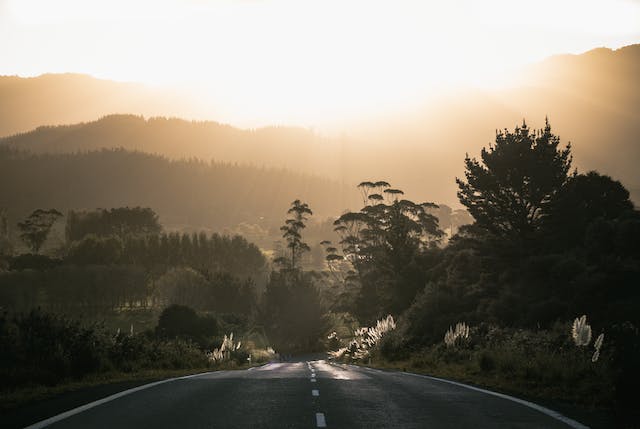
Pricing and Deals
When it comes to car rental in New Zealand, pricing can vary depending on the season, availability, and the type of vehicle you want to rent. However, there are always deals and discounts available that can help you save money.
One way to find deals is to book your rental car in advance. Many car rental companies offer discounts if you book early, so it’s worth checking out their websites or contacting them directly to see what deals they have available. Additionally, some companies offer discounts if you book for a certain number of days or if you rent during off-peak periods.
Another way to save money is to choose a budget car rental company. These companies often have lower rates than their competitors, but still offer reliable vehicles and good customer service. Some popular budget car rental companies in New Zealand include Jucy, Apex, and Go Rentals.
If you’re looking for cheap car rental deals, it’s also worth checking out comparison websites like Rentalcars.com or Expedia. These websites allow you to compare prices from multiple car rental companies, so you can find the best deal for your needs.
Finally, if you’re a member of a loyalty program or have a credit card that offers rental car discounts, be sure to take advantage of those benefits when renting a car in New Zealand.
Overall, there are plenty of ways to find deals and save money on car rental in New Zealand. By doing your research and comparing prices, you can find a reliable and affordable rental car that meets your needs.
Airport Locations
Car rental services in New Zealand are available at all major airports, including Auckland, Wellington, and Christchurch. These airports are the busiest and most popular in the country, with a high volume of domestic and international flights.
At Auckland Airport, car rental companies are located in the arrivals area of both the international and domestic terminals. The rental car pick-up and drop-off locations are conveniently situated near the terminal buildings, making it easy for travelers to access their rental cars.
Similarly, at Wellington Airport, car rental companies are located in the main terminal building, near the baggage claim area. The rental car parking area is located adjacent to the terminal, with easy access to the main road.
At Christchurch Airport, car rental companies are located in the arrivals area of the domestic and international terminals. The rental car parking area is located within walking distance of the terminal, making it easy for travelers to collect and drop off their rental cars.
Overall, renting a car at one of these major airports in New Zealand is a convenient and efficient way to explore the country. With a wide range of car rental companies to choose from, travelers can easily find a rental car that suits their needs and budget.
Off-Airport Rental Car Locations
In addition to the rental car companies located at the airport, there are also several off-airport rental car locations in New Zealand. These locations can be a convenient option for travelers who are not flying into one of the major airports or who prefer to avoid the crowds and long lines at the airport rental car counters.
Off-airport rental car locations can be found in many of the major cities and towns throughout New Zealand. Some of the most popular rental car companies that have off-airport locations include Avis, Budget, Hertz, and Thrifty. These companies typically offer a wide range of vehicles to choose from, including economy cars, SUVs, and luxury vehicles.
One of the benefits of renting a car from an off-airport location is that it can often be less expensive than renting from the airport. In addition, many off-airport rental car locations offer free shuttle service to and from the airport, making it easy to get to your rental car without having to pay for a taxi or other transportation.
When renting a car from an off-airport location, it is important to check the hours of operation and make sure that the location is open when you need to pick up or drop off your rental car. Some off-airport locations have limited hours of operation, so it is important to plan ahead to avoid any issues.
Overall, renting a car from an off-airport location can be a convenient and cost-effective option for travelers in New Zealand. With a wide range of rental car companies to choose from and free shuttle service to and from the airport, it is easy to find the perfect rental car for your needs.
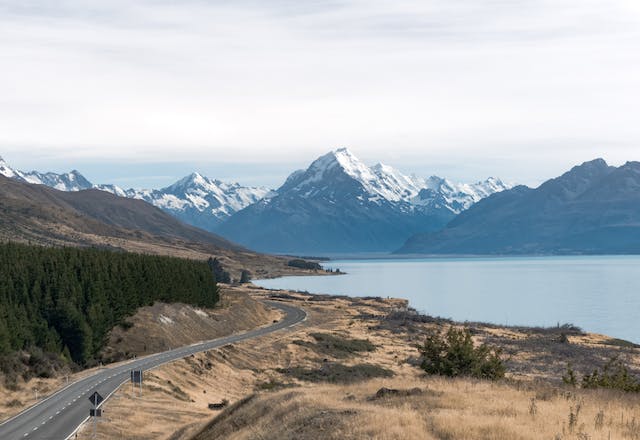
Car Rentals in Major Cities
When it comes to car rentals in New Zealand, major cities such as Auckland, Wellington, and Christchurch are the most popular locations. Each city has its own unique attractions and sights to explore, making car rental an ideal transportation option for tourists.
Auckland Car Rentals
Auckland is located on the North Island of New Zealand and is known for its beautiful harbors and beaches. Visitors can rent a car from one of the many car rental companies located in the city, such as Avis, Budget, or Hertz. Some popular attractions to visit include the Sky Tower, Auckland Harbour Bridge, and the Auckland Zoo.
Wellington Car Rentals
Wellington is the capital city of New Zealand and is located on the southern tip of the North Island. Visitors can rent a car from one of the many car rental companies located in the city, such as Europcar, Thrifty, or Enterprise. Some popular attractions to visit include the Wellington Cable Car, Te Papa Museum, and the Wellington Botanic Garden.
Christchurch Car Rentals
Christchurch is located on the South Island of New Zealand and is known for its stunning scenery and outdoor activities. Visitors can rent a car from one of the many car rental companies located in the city, such as Sixt, Ace Rental Cars, or Apex Car Rentals. Some popular attractions to visit include the Christchurch Gondola, the International Antarctic Centre, and the Christchurch Botanic Gardens.
Overall, renting a car in New Zealand is a convenient and cost-effective way to explore the major cities and surrounding areas. With a variety of car rental companies to choose from and a multitude of attractions to visit, renting a car is a great option for any tourist looking to explore New Zealand’s beauty.
Car Rentals in Other Locations
For those looking to explore more of New Zealand, there are plenty of other locations outside of the major cities where car rentals are available. Here are some options to consider:
Queenstown Car Rentals
Queenstown is a popular destination for adventure seekers and those looking to explore the stunning natural beauty of the South Island. There are several car rental companies located in Queenstown, including Avis, Budget, and Hertz. Many of these companies offer a range of vehicles, from compact cars to SUVs, to suit different travel needs.
Wanaka Car Rentals
Wanaka is a charming town located near the Southern Alps and Lake Wanaka. It’s a great place to base yourself if you’re interested in outdoor activities like hiking, skiing, or mountain biking. Car rental companies in Wanaka include Apex, Europcar, and Thrifty, among others. Visitors can choose from a variety of vehicles, including luxury cars and 4WDs.
Rotorua Car Rentals
Rotorua is known for its geothermal activity, Maori culture, and scenic beauty. It’s a popular destination for families and adventure seekers alike. There are several car rental companies located in Rotorua, including Avis, Budget, and Thrifty. Visitors can choose from a range of vehicles, including economy cars and people movers.
Overall, there are many car rental options available in New Zealand, including in smaller towns and cities. Visitors should do their research and compare prices and vehicle options to find the best rental for their needs.
Driving in New Zealand
Driving in New Zealand is generally safe and straightforward, but there are a few things to keep in mind. First, it is important to note that traffic drives on the left-hand side of the road in New Zealand. This may take some getting used to for drivers from countries where traffic drives on the right-hand side.
Speed limits in New Zealand are generally lower than in other countries, with a maximum speed limit of 100 km/h on the open road and 50 km/h in urban areas. It is important to obey these speed limits, as well as any other posted signs, to ensure safe driving.
Child restraint laws in New Zealand require children under the age of seven to be secured in an approved child restraint appropriate for their age and size. Children aged seven and older must use a seatbelt or child restraint if available.
Overall, driving in New Zealand can be a pleasant and enjoyable experience, with stunning scenery and well-maintained roads. However, it is important to drive safely and obey all traffic laws to ensure a safe and enjoyable trip.
Exploring New Zealand
New Zealand is a country full of natural beauty and adventure. With car rental services available, exploring this stunning country has never been easier. From the rugged mountains to the beautiful beaches, New Zealand has something for everyone.
One of the most popular natural attractions in New Zealand is Milford Sound. This stunning fjord is located in the Fiordland National Park and is known for its towering cliffs and crystal-clear waters. Visitors can take a boat tour or kayak through the sound to experience its beauty up close.
For those seeking adventure, New Zealand has plenty to offer. The country is known for its bungee jumping, skydiving, and skiing. Queenstown is a popular destination for adventure seekers, with activities such as jet boating and white water rafting available.
Aotearoa, the Māori name for New Zealand, is a country with a rich cultural heritage. Visitors can experience Māori culture through traditional performances, food, and art. The Te Papa museum in Wellington is a great place to learn more about the history and culture of New Zealand.
Overall, New Zealand is a country that offers something for everyone. With car rental services available, visitors can easily explore all that this stunning country has to offer.
Public Transportation Alternatives
For travelers who prefer not to rent a car, there are several public transportation options available in New Zealand. These options include buses, trains, and ferries.
Buses
Buses are a popular mode of transportation in New Zealand and are available in most cities and towns. The country’s largest bus operator is Intercity, which offers services between major cities and towns. Other bus operators include ManaBus, Naked Bus, and Kiwi Experience.
Trains
New Zealand has a limited rail network, with services primarily focused on the North Island. The country’s main train operator is KiwiRail, which offers scenic train journeys such as the Northern Explorer and the Coastal Pacific.
Ferries
Ferries are a popular way to travel between the North and South Islands of New Zealand. The country’s largest ferry operator is Interislander, which operates between Wellington and Picton. Other ferry operators include Bluebridge and StraitNZ.
Overall, public transportation in New Zealand is reliable and affordable, making it a great option for travelers who do not want to rent a car.
Final Thoughts
Overall, car rental is a great option for those looking to explore New Zealand at their own pace. With a variety of rental options available, from small economy cars to larger SUVs, there is something to suit every traveler’s needs and budget.
When it comes to discounts, it is always worth checking with the rental companies directly to see if they have any current promotions or deals available. Additionally, booking in advance can often result in lower rates.
One thing to keep in mind is that driving in New Zealand can be quite different from other countries, with narrow and winding roads, as well as driving on the left-hand side of the road. It is important to take your time and drive cautiously to ensure a safe and enjoyable trip.
In conclusion, renting a car in New Zealand can be a convenient and cost-effective way to explore the country’s stunning scenery and unique culture. By doing your research and taking necessary precautions, you can have a memorable and stress-free road trip experience.
Frequently Asked Questions
What are some of the best car rental companies in New Zealand?
New Zealand has a number of reputable car rental companies that offer a range of vehicles to suit different needs and budgets. Some of the best car rental companies in New Zealand include Hertz, Avis, Budget, Europcar, and Thrifty.
How much does it cost to rent a car in New Zealand?
The cost of renting a car in New Zealand varies depending on a number of factors, including the type of vehicle, the rental period, and the location. On average, you can expect to pay between $30 and $100 per day for a standard car rental.
What is the process for renting a car in New Zealand?
The process for renting a car in New Zealand is relatively straightforward. You will need to provide a valid driver’s license, a credit card for payment, and proof of insurance. Most car rental companies will also require a deposit, which will be refunded when you return the vehicle.
What documents do I need to rent a car in New Zealand?
To rent a car in New Zealand, you will need a valid driver’s license from your home country or an International Driving Permit (IDP). You will also need a credit card for payment and proof of insurance.
Can foreigners rent cars in New Zealand?
Yes, foreigners can rent cars in New Zealand as long as they meet the requirements for a valid driver’s license and insurance. If you have an overseas driver’s license, you can use it for up to 12 months in New Zealand before you will need to obtain a New Zealand driver’s license.
Are there any additional fees or charges when renting a car in New Zealand?
Some car rental companies in New Zealand may charge additional fees or charges, such as a young driver surcharge if you are under 25 years old, a one-way rental fee if you drop off the car at a different location, or a fee for additional drivers. It is important to read the rental agreement carefully and ask any questions before signing.
Does It Snow in Australia? Exploring the Country’s Winter Weather
Australia is a country known for its warm, sunny climate and sandy beaches. However, many people wonder if it ever snows in Australia. The answer is yes, it does snow in Australia, but not in all parts of the country.
Understanding Australia’s climate is essential to understanding where and when it snows in the country. Australia is a vast continent with a diverse climate, ranging from tropical in the north to temperate in the south. The southern parts of the country experience colder temperatures during the winter months, making it more likely to snow in these regions. However, the amount of snowfall varies depending on the location and altitude.
Key Takeaways
- Australia does receive snowfall, but not in all parts of the country.
- The southern parts of Australia are more likely to receive snowfall during the winter months.
- The amount of snowfall varies depending on the location and altitude.
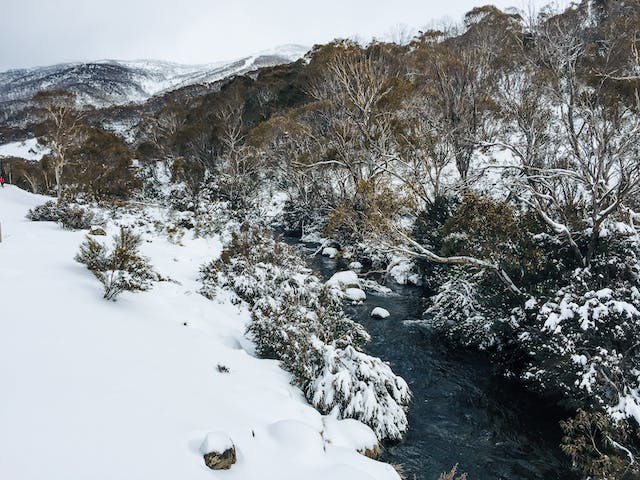
Understanding Australia’s Climate
Australia is a vast continent with a diverse range of climates. The country’s location in the southern hemisphere means that its seasons are the opposite of those in the northern hemisphere. The climate in Australia is generally hot and dry, with mild winters and plenty of sunshine throughout the year.
The temperatures in Australia can vary greatly depending on the region. The northern parts of the country have a tropical climate with high temperatures and high humidity, while the southern parts have a more temperate climate with cooler temperatures.
Australia’s climate is also affected by its latitude. The country is situated between the tropics and the Antarctic, which means that different regions experience different weather patterns. The north of the country experiences a wet season during the summer months, while the south has a more temperate climate with distinct seasons.
Despite its reputation for hot and dry climates, Australia does experience snowfall in some regions. The Snowy Mountains in New South Wales and Victoria are popular destinations for winter sports enthusiasts, and snow can also be found in Tasmania during the winter months.
In summary, Australia’s climate is diverse and can vary greatly depending on the region. While the country is known for its hot and dry climates, it also experiences mild winters and even snowfall in some areas.
Geographical Distribution of Snow in Australia
Australia is a country known for its warm and sunny climate, but there are some areas where it snows during the winter months. The snowfall in Australia is limited to the southeastern and southern parts of the country, where the mountainous regions receive enough precipitation to create snow.
The snowy regions of Australia are mainly found in Tasmania, Victoria, and New South Wales. The Snowy Mountains, Mount Buller, the Victorian Alps, Charlotte Pass, the Australian Alps, and the High Country are some of the popular destinations for snow enthusiasts.
The Snowy Mountains, located in New South Wales, is the highest mountain range in Australia and is famous for its ski resorts. Mount Buller, located in Victoria, is another popular destination for snow sports.
The alpine region of Australia, which includes the Snowy Mountains, the Victorian Alps, and the Australian Alps, receives the most snowfall in the country. The area is also known for its stunning landscapes and unique flora and fauna.
Although the snowy regions of Australia are popular among tourists and locals alike, it is important to note that snow is not a common occurrence in most parts of the country. The majority of Australia’s population lives in urban areas, including Sydney and the Australian Capital Territory, where snow is a rare sight.
Overall, while snow is not a defining characteristic of Australia, the country does have some beautiful snowy regions that are worth exploring.
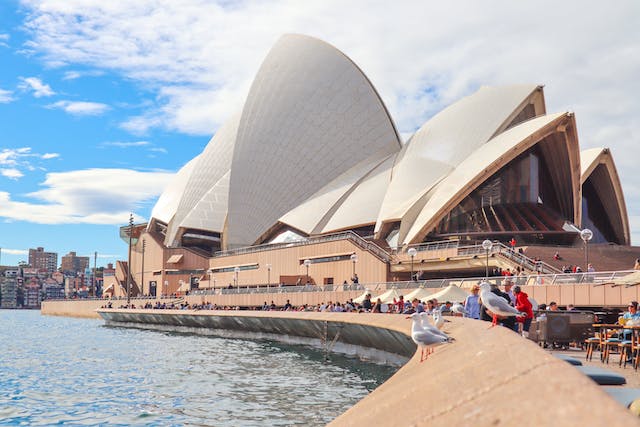
Snowfall Patterns and Seasons
Australia is not typically associated with snowfall, but it does snow in some parts of the country during the winter season. The snow season in Australia usually runs from June to October, with the peak season being in July and August.
Snowfall in Australia is generally limited to the southeastern regions of the country, particularly in the Snowy Mountains and the Australian Alps. These areas experience frigid polar air during the winter season, which can lead to cold snaps and temperatures dropping below freezing.
The amount of snowfall in Australia varies from year to year, with some winters seeing heavy snowfall and others seeing very little. The Snowy Mountains region typically receives the most snowfall, with an average of around 2 meters per year.
In addition to snowfall, the winter season in Australia is also characterized by cold temperatures and frost. The average temperature in the Snowy Mountains during winter is around -5°C, with temperatures occasionally dropping as low as -15°C.
Despite the snow season being a major draw for tourists, it is important to note that snowfall in Australia is not as reliable as in other countries known for winter sports. Visitors are advised to check snow conditions before planning a trip to ensure that there is enough snow for their desired activities.
Overall, while snowfall in Australia may not be as common or reliable as in other parts of the world, the Snowy Mountains and Australian Alps offer a unique winter experience for those looking to escape the heat and enjoy some winter sports. Even in the cold, it can be hard work and you’ll need some active wear detergent to take care of your snowboarding or skiing gear. Don’t let the weather fool you – its easy to break out a sweat on the slopes.
Australia’s Ski Resorts
Australia has several ski resorts that offer winter sports enthusiasts a variety of options for skiing, snowboarding, and other winter activities. Some of the most popular ski resorts in Australia include Perisher, Thredbo, Falls Creek, and Mount Kosciuszko.
Perisher is the largest ski resort in the southern hemisphere, with over 1,200 hectares of skiable terrain. It has 47 lifts and over 100 runs, making it a great choice for skiers and snowboarders of all levels. Thredbo is another popular ski resort, located in the Kosciuszko National Park. It has a wide range of runs, from beginner to advanced, and also offers night skiing.
Falls Creek is located in Victoria and is known for its family-friendly atmosphere. It has over 90 runs and is a great choice for beginners and intermediate skiers. Mount Kosciuszko, the highest peak in Australia, is also located in the Kosciuszko National Park and offers some great skiing and snowboarding opportunities.
For those who are new to skiing or snowboarding, many of the ski resorts in Australia offer lessons and equipment rental. It’s important to dress appropriately for the cold weather, with layers being key to staying warm. Tubing is another popular winter activity at some of the ski resorts, offering a fun alternative to skiing and snowboarding.
The ski season in Australia typically runs from June to October, with the peak season being in July and August. The Skitube, a train that runs from Jindabyne to Perisher, is a convenient way to get to the ski resorts in the Kosciuszko National Park.
Overall, Australia’s ski resorts offer a range of options for winter sports enthusiasts, from beginners to advanced skiers and snowboarders. With plenty of runs, lessons, and equipment rental available, it’s a great destination for a winter holiday.

Unique Aspects of Australian Snow
Australia is a unique country in many ways, and its snow is no exception. While it may not have the same reputation for snow as some other countries, there are still many interesting aspects to Australian snow that are worth exploring.
One of the most unique aspects of Australian snow is its seasonality. While most people associate snow with winter, in Australia, it is actually more common during the summer months. This is because the snow falls in the mountainous areas of the country, which are at a high enough elevation to be cold even during the warmer months.
Another interesting aspect of Australian snow is its distribution. While it can be found in several areas around the country, it is most common in the southern states, such as South Australia and Victoria. However, it is still possible to find snow in other areas, such as the Snowy Mountains in New South Wales.
The type of terrain that Australian snow falls on is also unique. Unlike many other countries, where snow falls on grasslands or moderately fertile soil, in Australia, it falls on mountainous areas with rocky, rugged terrain. This can make it more challenging to ski or snowboard, but also adds to the sense of adventure and excitement.
Finally, it is worth noting that Australian snow is quite different from the snow found in places like Antarctica or northern hemisphere countries like Canada or the United States. While it can be just as beautiful and enjoyable, it is important to remember that it has its own unique qualities and should be appreciated on its own terms.
In summary, Australian snow is a fascinating and unique phenomenon that offers many opportunities for adventure and exploration. Whether you are an avid skier or just enjoy the beauty of snow-covered landscapes, there is something special about the snow in Australia that is worth experiencing for yourself.
Australia’s snow is truly fascinating, especially in the snowy mountains and ski resorts. Custom Keyrings are a great way to commemorate this unique experience. You can design your keychain in the shape of a snowflake, or engrave snowy mountains or skiing-related elements on it, which can well reflect the characteristics of Australia.
In terms of color design, you can use white, blue, or silver to represent the theme of snow and ice, which can make the keychain more vivid. In addition, you can also engrave your name and travel date on the back of the keychain to increase commemorative significance.

Snow in Major Cities
Australia is a country known for its warm and sunny weather, but some parts of the country do experience snowfall during winter. While it’s not a common occurrence, snowfall can be seen in some of the major cities of Australia.
Melbourne, the capital of Victoria, is one of the few cities in Australia that experiences snowfall. The city sees snowfall once every few years, with the last significant snowfall occurring in 2015. The snowfall is usually light and doesn’t last long, but it’s still a rare and exciting event for the locals.
Sydney, the capital of New South Wales, doesn’t usually experience snowfall due to its coastal location and mild winters. However, the city has seen snowfall in the past, with the last recorded snowfall occurring in 1836. Snowfall in Sydney is extremely rare and unlikely to happen again anytime soon.
Canberra, the capital of Australia, is located in the Australian Capital Territory and experiences snowfall during winter. The city sees an average of 20 snow days per year, with the snowfall usually occurring in July and August. The snowfall is often light, but it’s enough to create a winter wonderland feel in the city.
Hobart, the capital of Tasmania, is another city in Australia that experiences snowfall during winter. The city sees snowfall once every few years, with the last significant snowfall occurring in 2015. The snowfall is usually light and doesn’t last long, but it’s still a rare and exciting event for the locals.
Queensland, South Australia, and Western Australia are all located in the northern and western parts of Australia and don’t usually experience snowfall due to their warm climates. However, some parts of these states, such as the high-altitude regions, can experience snowfall during winter.
In summary, while snowfall is not a common occurrence in Australia, some of the major cities do experience snowfall during winter. It’s a rare and exciting event for the locals, and it adds a unique touch to the winter season in Australia.
Temperature Range and Weather Conditions
Australia is a vast country with diverse weather conditions and temperature ranges. The country experiences a wide range of temperatures throughout the year, from hot and dry to cold and wet, depending on the region. The temperature range in Australia varies greatly from one part of the country to another.
The northern parts of Australia, such as Darwin and Cairns, have a tropical climate with high temperatures and humidity throughout the year. The average temperature in these regions ranges from 25°C to 33°C. The southern parts of Australia, such as Melbourne and Sydney, have a temperate climate with mild temperatures in winter and warm temperatures in summer. The average temperature in these regions ranges from 10°C to 25°C.
During the winter months, some parts of Australia, such as the Snowy Mountains and Tasmania, experience snowfall. However, snowfall is not common in most parts of the country, and it is a rare occurrence in the major cities. The winter months in Australia are generally mild, with temperatures ranging from 5°C to 20°C.
Australia is also known for its extreme weather conditions, such as bushfires, floods, and cyclones. These weather events can occur at any time of the year and can have a significant impact on the temperature and climate of the affected regions.
Overall, the temperature range and weather conditions in Australia vary greatly depending on the region. It is essential to check the weather forecast before traveling to any part of the country to ensure that you are prepared for the conditions.
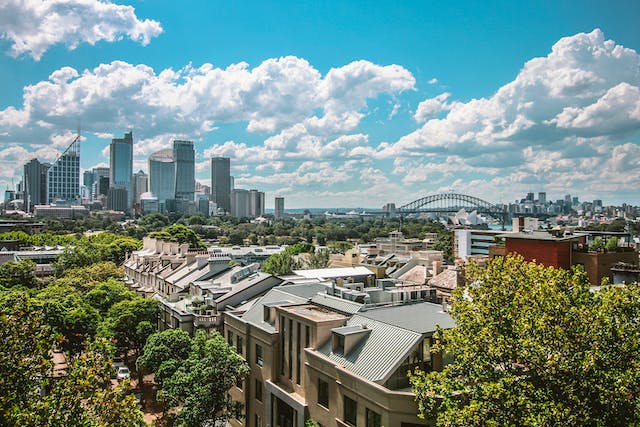
Frequently Asked Questions
Best places to see snow near Sydney
If you are in Sydney and want to experience snow, you can head towards the Snowy Mountains which is a popular destination for snow lovers. It is a 5-hour drive from Sydney, and there are many ski resorts in the area. The most popular ski resorts in the Snowy Mountains are Perisher and Thredbo.
Where does it snow in Australia on a map?
The Snowy Mountains in New South Wales and the Victorian Alps are the two main areas where it snows in Australia. You can find a map of these areas online to help plan your trip.
Does it snow in Canberra?
Yes, it does snow in Canberra, but it’s not a common occurrence. The city experiences snowfall once in a while, usually during winter.
Does it snow in Adelaide?
Adelaide is not known for snowfall as it is located in a warmer region of Australia. Snowfall in Adelaide is rare and occurs once in a blue moon.
Does it snow in Brisbane, Australia?
Brisbane is located in a subtropical region, and it’s not common for it to snow in the city. However, there have been instances of snowfall in the surrounding regions of Queensland.
Where does it snow in NSW?
The Snowy Mountains in New South Wales are the main area where it snows in NSW. The region is home to many ski resorts, and it’s a popular destination for snow lovers.
Name an Animal You Might Find in Australia: A Guide to the Country’s Unique Wildlife
Australia is home to a diverse range of animals that are unique to the continent. From kangaroos and wallabies to koalas and wombats, there are many iconic species that are instantly recognizable as Australian. However, there are also many other animals that are lesser-known but just as fascinating, such as the platypus, echidna, and Tasmanian devil.
One of the most interesting things about Australian animals is that many of them are marsupials, meaning that they carry their young in a pouch. Kangaroos, wallabies, and koalas are all marsupials, as are many other species. In addition to marsupials, Australia is also home to monotremes, which are mammals that lay eggs instead of giving birth to live young. The platypus and echidna are both monotremes and are unique to Australia.
Key Takeaways
- Australia is home to a diverse range of animals, many of which are unique to the continent.
- Many Australian animals are marsupials, carrying their young in a pouch, while others are monotremes, laying eggs instead of giving birth to live young.
- Some of the most iconic Australian animals include kangaroos, wallabies, koalas, platypuses, and echidnas.

Kangaroos and Wallabies
Australia is known for its unique wildlife, and kangaroos and wallabies are some of the most iconic animals found in the country. These marsupials are often seen hopping around in the wild or grazing in open fields.
Kangaroo Island
Kangaroo Island is a popular tourist destination located off the coast of South Australia. As the name suggests, it is home to a large population of kangaroos, as well as other wildlife such as wallabies, echidnas, and koalas. Visitors can take guided tours or explore the island on their own to catch a glimpse of these fascinating animals in their natural habitat.
Red Kangaroo
The red kangaroo is the largest marsupial in the world, and can be found throughout most of Australia’s interior. These animals are well-adapted to life in the arid regions of the country, and can survive for long periods without water. Red kangaroos are known for their powerful hind legs, which allow them to hop at high speeds and cover great distances with ease.
Overall, kangaroos and wallabies are an important part of Australia’s unique ecosystem, and are a must-see for anyone visiting the country.
Koalas and Wombats
Koala Habitats
Koalas are marsupials that are native to Australia. They are found in forests and woodlands, as well as in urban areas where there are eucalyptus trees. Koalas are known for their distinctive appearance, with fluffy ears and a round face. They are also known for their diet of eucalyptus leaves, which is the only food they eat.
Koalas live in trees and are well adapted to their arboreal lifestyle. They have strong limbs and sharp claws that help them climb and grip onto branches. They also have a unique digestive system that allows them to break down the toxic compounds found in eucalyptus leaves.
Wombat Characteristics
Wombats are another marsupial species found in Australia. They are known for their stocky build and short legs. Wombats are herbivores and primarily eat grasses, roots, and bark.
Wombats are well adapted to their burrowing lifestyle. They have strong legs and claws that help them dig burrows, which they use for shelter and protection. Wombats are also known for their tough hides, which can protect them from predators.
In conclusion, koalas and wombats are two unique marsupial species found in Australia. They have adapted to their respective habitats and lifestyles, making them well-suited to survive in their environments.
Unique Marsupials
Australia is home to a variety of unique marsupials. These animals are characterized by their distinctive reproductive system, in which the young are born at a very early stage of development and then complete their growth outside the womb, attached to a teat on the mother’s abdomen.
Tasmanian Devils
One of the most well-known marsupials found in Australia is the Tasmanian devil. These carnivorous marsupials are native to the island state of Tasmania and are known for their strong jaws and aggressive behavior. Unfortunately, Tasmanian devils are currently facing a serious threat from a contagious facial tumor disease, which has caused a significant decline in their population.
Sugar Glider and Bandicoots
Other unique marsupials found in Australia include the sugar glider and bandicoots. The sugar glider is a small, tree-dwelling marsupial that is known for its ability to glide through the air using flaps of skin between its legs. Bandicoots, on the other hand, are small to medium-sized marsupials that are found throughout Australia and are known for their long, pointed snouts.
In conclusion, Australia is home to a diverse range of marsupials, including the Tasmanian devil, sugar glider, and bandicoots. These unique animals are an important part of Australia’s natural heritage and are worth protecting for future generations to enjoy.
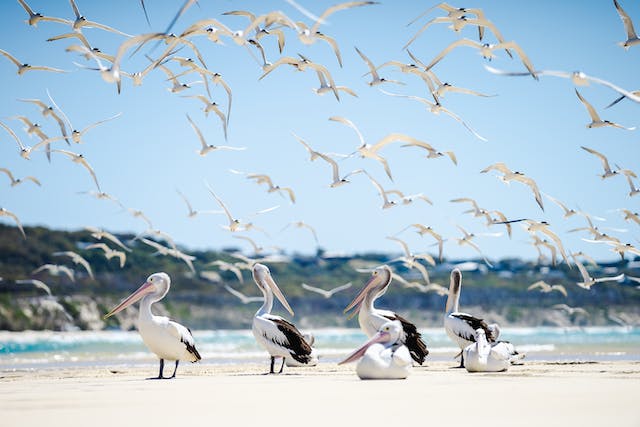
Monotremes
Monotremes are a unique group of mammals found only in Australia and New Guinea. They are characterized by their ability to lay eggs instead of giving birth to live young. There are only two types of monotremes: the platypus and the echidnas.
Platypus
The platypus, also known as the spiny anteater, is one of the most unusual animals in the world. It has a duck-like bill, webbed feet, and a beaver-like tail. The platypus is a semi-aquatic animal that lives in streams and rivers in eastern Australia. It is a nocturnal animal that feeds on small invertebrates, such as insects and crustaceans. The platypus is also one of the few venomous mammals in the world. The male platypus has spurs on its hind legs that can deliver a painful venom to predators or other males during mating season.
Echidnas
Echidnas, also known as spiny anteaters, are another type of monotreme found in Australia and New Guinea. They are covered in spines and have a long snout for feeding on ants and termites. Echidnas are also known for their ability to curl up into a ball when threatened, exposing only their spines for protection. There are two species of echidnas: the short-beaked echidna and the long-beaked echidna. Both species are found in Australia, but the long-beaked echidna is also found in New Guinea.
In conclusion, monotremes are a fascinating group of animals that are unique to Australia and New Guinea. The platypus and echidnas are two examples of these unusual mammals, each with their own unique characteristics and adaptations.
Birds of Australia
Australia is home to a wide variety of bird species, some of which are found nowhere else in the world. From colorful parrots to flightless emus, Australia’s bird life is diverse and fascinating. Here are a few of the most notable bird species found in Australia:
Emus
The emu is a large, flightless bird that is native to Australia. It is the second-largest bird in the world after the ostrich and can grow up to 6 feet tall. Emus have long, powerful legs that allow them to run at speeds of up to 30 miles per hour. They are also known for their distinctive call, which sounds like a deep drumming noise.
Kookaburra
The kookaburra is a type of kingfisher that is found throughout Australia. It is known for its distinctive call, which sounds like laughter. Kookaburras are carnivorous and feed on a variety of prey, including insects, reptiles, and small mammals. They are also known to steal food from other birds.
Cassowary
The cassowary is a large, flightless bird that is found in the tropical rainforests of northeastern Australia. It is known for its distinctive, brightly colored head and neck. Cassowaries are important seed dispersers in their habitat and play an important role in maintaining the health of the rainforest ecosystem.
Overall, Australia’s bird life is diverse and fascinating, with many unique species that are found nowhere else in the world. From the flightless emu to the colorful rainbow lorikeet, Australia’s birds are a testament to the country’s rich natural heritage.
Australia’s Predators
Australia is home to some of the most dangerous predators in the world. From land to sea, these animals are feared by many and respected by all.
Dingoes
The dingo is a wild dog that is native to Australia. They are known for their distinctive howl, and they can be found in many parts of the country. Dingoes are apex predators, which means that they are at the top of the food chain in their ecosystem. They are opportunistic hunters and will eat almost anything, including small mammals, birds, and reptiles.
Saltwater and Freshwater Crocodiles
Australia is home to two species of crocodiles: the saltwater crocodile and the freshwater crocodile. Saltwater crocodiles are the largest reptiles in the world, and they can grow up to 23 feet in length. They are found in the northern parts of Australia, and they are known for their aggressive nature. Freshwater crocodiles, on the other hand, are smaller and less dangerous than their saltwater counterparts. They are found in the rivers and lakes of northern Australia.
Great White Sharks
Great white sharks are one of the most feared predators in the world, and they can be found in the waters off the coast of Australia. They are known for their size and their powerful jaws, which can crush bones with ease. Great white sharks are apex predators, and they feed on a variety of marine life, including fish, seals, and other sharks.
In conclusion, Australia is home to some of the most dangerous predators in the world. From dingoes to crocodiles to great white sharks, these animals are feared and respected by all who encounter them.

Australia’s Unique Reptiles
Australia is home to some of the most unique reptiles in the world. From the spiny Thorny Devil to the venomous Inland and Coastal Taipans, these reptiles have adapted to the harsh Australian environment in fascinating ways.
Thorny Devil
The Thorny Devil, also known as the Moloch, is a small lizard that is covered in sharp, spiny scales. These scales help protect the lizard from predators, as well as help it absorb water from its skin. The Thorny Devil is also known for its ability to change color, depending on the temperature and the lizard’s mood.
Inland and Coastal Taipan
The Inland Taipan and Coastal Taipan are two of the most venomous snakes in the world. The Inland Taipan, also known as the Fierce Snake, has the most toxic venom of any snake. Despite this, it is rarely encountered by humans due to its remote habitat. The Coastal Taipan, also known as the Eastern Taipan, is found along the eastern coast of Australia and is responsible for the majority of snakebite deaths in the country.
Monitor Lizards
Monitor Lizards, also known as Goannas, are a group of large lizards that are found throughout Australia. They are known for their powerful jaws and sharp teeth, which they use to catch and eat a variety of prey. The largest species, the Perentie, can grow up to 2.5 meters in length.
Australia’s reptiles, including the Thorny Devil, Inland and Coastal Taipans, and Monitor Lizards, are fascinating examples of how animals have adapted to the unique environment of the continent. While some of these reptiles are venomous and dangerous, they play an important role in the ecosystem and should be respected from a safe distance.
Australia’s Spiders
Australia is home to a wide variety of spiders, many of which are unique to the continent. Two of the most well-known species are the Funnel-Web Spider and the Redback Spider.
Funnel-Web Spider
The Funnel-Web Spider is one of the most dangerous spiders in the world. There are several species of Funnel-Web Spider, but the most well-known is the Sydney Funnel-Web Spider. This spider is found in the Sydney area and is known for its aggressive behavior and toxic venom.
The Sydney Funnel-Web Spider is a large, black spider with a shiny, hairless body. Its fangs are large and powerful, and its venom can cause serious illness or death in humans. Symptoms of a bite include sweating, muscle spasms, and difficulty breathing.
Redback Spider
The Redback Spider is another dangerous spider found in Australia. It is a member of the widow spider family and is known for its distinctive red stripe on its back. The Redback Spider is found throughout Australia and is commonly found in urban areas.
Like the Funnel-Web Spider, the Redback Spider has powerful venom that can cause serious illness or death in humans. Symptoms of a bite include sweating, nausea, and muscle pain.
Overall, it is important to be cautious around spiders in Australia, especially the Funnel-Web Spider and the Redback Spider. If you encounter one of these spiders, it is best to keep your distance and seek medical attention if you are bitten.
Other Unique Animals
Australia is home to many unique animals that cannot be found anywhere else in the world. While kangaroos and koalas are well-known, there are other interesting creatures that are worth learning about.
Quokka
The quokka is a small marsupial that can only be found in Western Australia. They are known for their friendly and curious nature, and are often referred to as the “world’s happiest animal”. Quokkas are about the size of a domestic cat and have a round face with a short snout. They are herbivores and feed on grasses, leaves, and bark.
Dugong
Dugongs are large marine mammals that live in the waters around northern Australia. They are related to manatees and are sometimes referred to as “sea cows”. Dugongs can grow up to three meters long and can weigh up to 500 kilograms. They are herbivores and feed on seagrasses. Dugongs are considered vulnerable due to habitat loss and hunting.
Australian Sea Lion
The Australian sea lion is a unique species of sea lion that is found only in Australia. They are the only species of sea lion that breeds exclusively in Australia. Australian sea lions are smaller than other species of sea lions and have a light brown coat. They are known for their agility and are able to swim up to 40 kilometers per hour.
Overall, Australia is home to many unique and fascinating animals. The quokka, dugong, and Australian sea lion are just a few examples of the diverse wildlife that can be found in this amazing country.
Australia’s Habitats
Australia is a vast continent with a diverse range of habitats, from dense rainforests to arid deserts. These habitats are home to a variety of unique flora and fauna, including some of the most iconic animals in the world. In this section, we will explore some of the major habitats found in Australia and the animals that call them home.
Forests
Forests cover approximately 16% of Australia’s land area and are found in both tropical and temperate regions. The most famous forest in Australia is the Daintree Rainforest in Queensland, which is home to a staggering array of plant and animal species. Some of the animals that can be found in Australian forests include:
- Koalas
- Kangaroos
- Wallabies
- Wombats
- Possums
- Gliders
- Birds such as the lyrebird and kookaburra
Woodlands
Woodlands are characterized by their open canopy and scattered trees, and are found throughout much of Australia. They are home to a diverse range of animals, including:
- Emus
- Kangaroos
- Wallabies
- Echidnas
- Goannas
- Snakes
- Birds such as the wedge-tailed eagle and cockatoo
Grasslands
Grasslands are found in both tropical and temperate regions of Australia and are dominated by grasses and other herbaceous plants. They are home to a variety of animals, including:
- Kangaroos
- Wallabies
- Emus
- Bilbies
- Wombats
- Snakes
- Birds such as the emu and bustard
Rainforests
Rainforests are characterized by their dense canopy and high levels of rainfall, and are found in tropical regions of Australia. They are home to a vast array of plant and animal species, including:
- Cassowaries
- Tree kangaroos
- Flying foxes
- Possums
- Birds such as the bowerbird and parrot
Australia’s habitats are diverse and unique, and are home to some of the most fascinating animals in the world. From the lush rainforests of the north to the arid deserts of the interior, each habitat has its own distinct ecosystem and set of species.
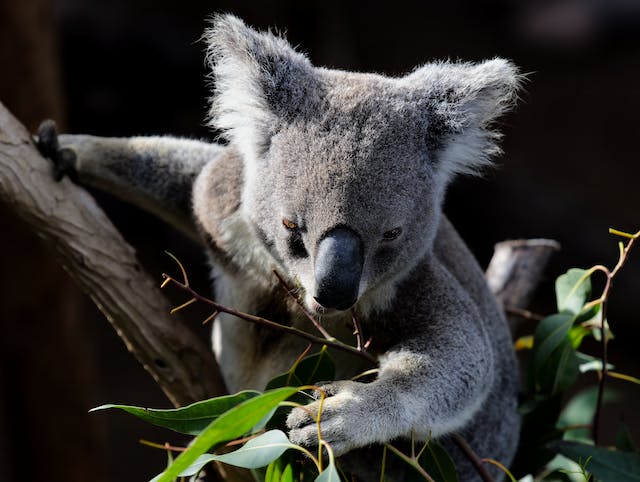
Australia’s States and Territories
Australia is made up of six states and two territories. Each of these regions has its own unique landscape, climate, and wildlife. In this section, we will explore the states and territories of Australia and the animals that can be found within them.
Queensland
Queensland is known for its tropical climate and diverse wildlife. The state is home to the Great Barrier Reef, which is the world’s largest coral reef system. Some of the animals that can be found in Queensland include:
- Kangaroos
- Koalas
- Crocodiles
- Dingoes
- Cassowaries
- Wombats
New South Wales
New South Wales is the most populous state in Australia and is home to the country’s largest city, Sydney. The state has a diverse range of landscapes, from the rugged Blue Mountains to the sandy beaches of the coast. Some of the animals that can be found in New South Wales include:
- Kangaroos
- Koalas
- Wombats
- Platypuses
- Emus
- Tasmanian Devils (in the southern part of the state)
Victoria
Victoria is the smallest mainland state in Australia but is home to a diverse range of wildlife. The state is known for its stunning coastline, rugged mountains, and vast forests. Some of the animals that can be found in Victoria include:
- Kangaroos
- Koalas
- Wombats
- Wallabies
- Echidnas
- Platypuses
Island State of Tasmania
Tasmania is an island state located off the southern coast of Australia. The state is known for its rugged wilderness areas, including the Tasmanian Wilderness World Heritage Area. Some of the animals that can be found in Tasmania include:
- Tasmanian Devils
- Wombats
- Wallabies
- Quolls
- Platypuses
- Echidnas
Overall, Australia is home to an incredible array of wildlife, much of which is found nowhere else in the world. Each state and territory has its own unique blend of flora and fauna, making it a fascinating destination for nature lovers.
Australia’s National Parks
Australia is home to a diverse range of wildlife, and its national parks offer visitors the chance to see some of the country’s most unique animals in their natural habitat. Here are some of Australia’s most popular national parks:
Blue Mountains National Park
Located just a short drive from Sydney, the Blue Mountains National Park is home to a wide variety of wildlife, including kangaroos, wallabies, and koalas. Visitors to the park can take a scenic drive through the mountains, hike one of the many trails, or take a guided tour to learn more about the park’s history and wildlife.
Kakadu
Kakadu National Park is located in the Northern Territory and is home to a wide variety of wildlife, including saltwater crocodiles, kangaroos, and wallabies. Visitors to the park can take a guided tour to learn more about the park’s Aboriginal history and culture, and can also explore the park’s many hiking trails and waterfalls.
Daintree
Located in Queensland, the Daintree National Park is home to a wide variety of wildlife, including the endangered cassowary, as well as a number of rare and exotic bird species. Visitors to the park can take a guided tour to learn more about the park’s unique flora and fauna, or can explore the park’s many hiking trails and waterfalls.
Wilsons Promontory
Located in Victoria, Wilsons Promontory National Park is home to a wide variety of wildlife, including kangaroos, wallabies, and wombats. Visitors to the park can take a guided tour to learn more about the park’s history and wildlife, or can explore the park’s many hiking trails and beaches.
Overall, Australia’s national parks offer visitors the chance to see some of the country’s most unique wildlife in their natural habitat. Whether you’re looking for a scenic drive, a challenging hike, or a chance to learn more about Australia’s Aboriginal history and culture, there’s a national park in Australia that’s sure to meet your needs.
Australia’s Cities and Wildlife Sanctuaries
Sydney
Sydney is one of the most popular cities in Australia, known for its stunning beaches and iconic landmarks such as the Sydney Opera House and Harbour Bridge. However, it is also home to a variety of Australian wildlife. Visitors can explore the Taronga Zoo, which features over 4,000 animals from over 350 species, including kangaroos, koalas, and Tasmanian devils.
Melbourne
Melbourne, the capital city of Victoria, is another popular destination in Australia. While it may not have the same reputation for wildlife as Sydney, it is home to the Melbourne Zoo, which boasts over 320 animal species, including the famous Australian marsupials like kangaroos and wallabies.
Brisbane
Brisbane, the capital city of Queensland, is known for its warm climate and outdoor activities. Visitors can explore the Lone Pine Koala Sanctuary, where they can get up close and personal with koalas, kangaroos, and other native Australian animals.
Perth
Perth is the capital city of Western Australia and is known for its beautiful beaches and parks. Visitors can explore the Perth Zoo, which features over 1,200 animals from around the world, including Australian wildlife like kangaroos, wallabies, and Tasmanian devils.
Wildlife Sanctuaries
Australia is home to a variety of wildlife sanctuaries, which are dedicated to protecting and preserving the country’s unique animals. Visitors can explore sanctuaries like the Healesville Sanctuary in Victoria, which focuses on protecting native Australian wildlife like koalas, kangaroos, and wombats. The Currumbin Wildlife Sanctuary in Queensland is another popular destination, where visitors can see koalas, kangaroos, and other Australian animals up close.
Overall, Australia’s cities and wildlife sanctuaries offer visitors a unique opportunity to experience the country’s diverse wildlife and natural beauty.
Frequently Asked Questions
What are some unique animals found in Australia?
Australia is home to many unique animals, including the kangaroo, koala, echidna, and platypus. These animals are found nowhere else in the world and are a source of pride for Australians.
What are some of the most dangerous animals in Australia?
Australia is also home to some of the world’s most venomous snakes, including the inland taipan, eastern brown snake, and tiger snake. Other dangerous animals include the saltwater crocodile, box jellyfish, and blue-ringed octopus.
What are some burrowing animals found in Australia?
Australia has several burrowing animals, including the wombat, bilby, and bandicoot. These animals have adapted to living in Australia’s dry and arid conditions by digging burrows to escape the heat.
What are some Australian mammals?
Australia has a diverse range of mammals, including the kangaroo, koala, wallaby, possum, and Tasmanian devil. These animals can be found in a variety of habitats, from rainforests to deserts.
What are some funny Australian animals?
Australia is home to many animals with unique and quirky personalities, including the kookaburra, quokka, and wombat. These animals are known for their playful behavior and are often featured in Australian culture and media.
What are some Australian animals that start with the letter ‘L’?
Australia has several animals that start with the letter ‘L’, including the lyrebird, lace monitor, and long-nosed bandicoot. These animals are unique to Australia and are an important part of its biodiversity.
Christmas in Australia: Celebrating the Holidays Down Under
Christmas in Australia is a unique experience that combines traditional Christmas celebrations with the country’s distinct culture and climate. While many of the customs and traditions are similar to those in other countries, there are also some distinct differences that make the holiday season in Australia truly special.
A notable distinction lies in the weather. Given that Christmas occurs during the summer months in Australia, it’s quite common to spend the day at the beach or enjoy a barbecue with loved ones. This stands in stark contrast to the snow and chilly temperatures often associated with Christmas in other regions. Additionally, does it snow in Australia?
Despite the differences, Christmas in Australia still includes many of the same traditions and customs that are celebrated in other countries. Families gather together to exchange gifts, decorate their homes with lights and ornaments, and enjoy special meals and treats. In the following article, we will explore the history and traditions of Christmas in Australia, as well as the unique experiences that make the holiday season in this country so special.
Key Takeaways
- Christmas in Australia combines traditional celebrations with the country’s distinct culture and climate.
- The warm weather during the holiday season allows for unique experiences such as beach trips and barbecues.
- Despite the differences, many of the same traditions and customs are still celebrated in Australia, including gift-giving, decorating, and special meals.
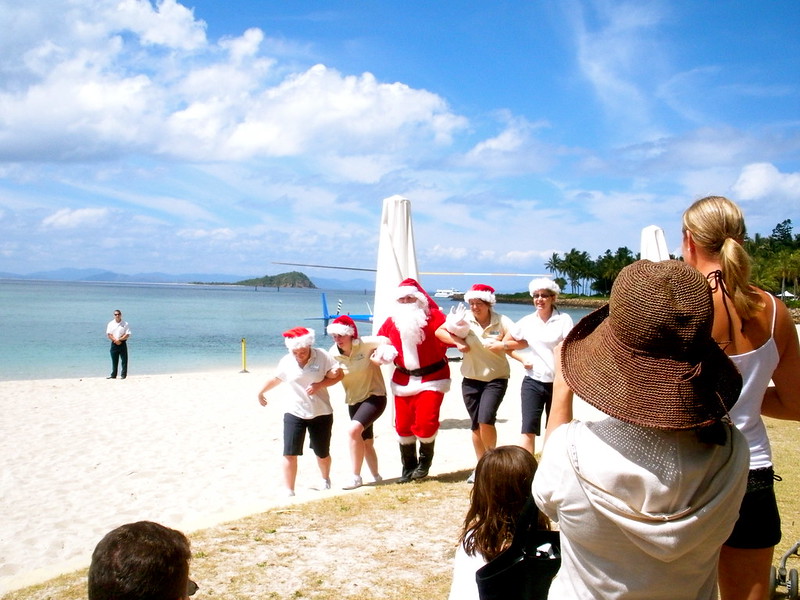
Christmas in Australia
Christmas in Australia is celebrated during the summer season, which falls in the Southern Hemisphere. Although it is celebrated in a different season, the traditions of Christmas are similar to those in other parts of the world.
The festive season in Australia is marked by decorations, carols, and the exchange of gifts. The streets are adorned with Christmas lights, and many homes display Christmas trees and other decorations.
One of the unique traditions of Christmas in Australia is the Carols by Candlelight event, which is held in many cities and towns. This event involves singing Christmas carols by candlelight, and it is a popular way to celebrate the festive season.
Another popular tradition in Australia is the Christmas lunch, which is often a barbeque or seafood feast due to the warm weather. Australians also enjoy spending time outdoors during Christmas, either at the beach or in the park.
Overall, Christmas in Australia is a time for family, friends, and celebration. Despite the differences in climate, Australians embrace the festive season with the same enthusiasm and joy as people in other parts of the world.
Historical Background and Traditions
Christmas in Australia has its roots in the Christian tradition, but it has evolved to include a unique blend of cultural and regional influences. Many of the traditions and customs associated with Christmas in Australia are similar to those in other parts of the world, but there are also some distinct differences.
One of the most notable differences is the fact that Christmas falls during the summer months in Australia, which means that many people celebrate the holiday outdoors. This has led to the development of a number of unique Australian Christmas traditions, such as barbecues, beach parties, and outdoor concerts.
Another key aspect of Australian Christmas traditions is the use of native plants and flowers to decorate homes and public spaces. The Christmas bush, for example, is a native Australian plant that blooms with red and green flowers during the holiday season. Other popular native plants used for decoration include the Christmas bells and the wattle.
Father Christmas, also known as Santa Claus, is a beloved figure in Australian Christmas traditions. However, he is often depicted wearing shorts and a t-shirt to reflect the warm weather. In addition, many Australians have adopted the tradition of leaving out a cold beer for Santa instead of milk and cookies.
Overall, Christmas in Australia is a unique and vibrant celebration that reflects the country’s diverse cultural heritage and natural beauty.
Preparations and Decorations
Christmas in Australia is celebrated during the summer season, which means that the preparations and decorations are slightly different from those in other countries. Australians start preparing for Christmas in November and December, which is the peak summer season.
Christmas Shopping
Christmas shopping is an important part of the preparations for Christmas in Australia. People start shopping for gifts and presents for their loved ones as early as November. The shopping malls and stores are decorated with Christmas lights, tinsel, and other decorations to create a festive atmosphere.
Home Decorations
Home decorations are an essential part of the Christmas celebrations in Australia. Australians decorate their homes with Christmas trees, tinsel, and other decorations. Many people also decorate their homes with Christmas lights to create a festive atmosphere.
The Christmas tree is the centerpiece of the home decorations. Australians usually decorate their Christmas trees with ornaments, tinsel, and lights. Some people also use natural decorations such as pine cones, holly, and mistletoe to decorate their homes.
In conclusion, preparations and decorations for Christmas in Australia start early in November and December. Australians love to shop for gifts and presents for their loved ones, and home decorations such as Christmas trees, tinsel, and lights are an essential part of the celebrations.
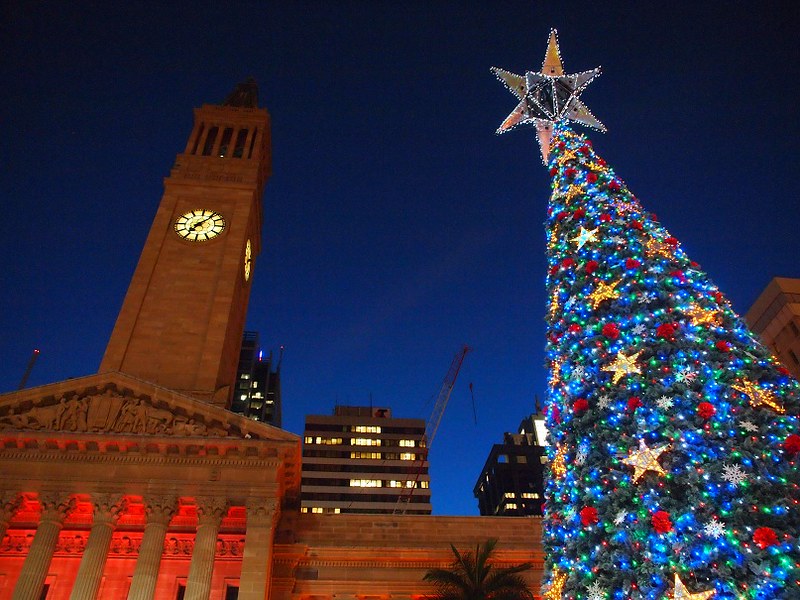
Christmas Eve and Day
Christmas Eve and Day are both celebrated in Australia with great enthusiasm. Although it is summer in Australia during this time, the festive spirit is no less than that in the northern hemisphere.
Carols by Candlelight
One of the most popular traditions during the Christmas season in Australia is Carols by Candlelight. This event is held in many cities and towns across the country, with the most famous ones being the Carols by Candlelight at the Sidney Myer Music Bowl in Melbourne and Carols in the Domain in Sydney. People gather in parks and open spaces, holding candles and singing traditional Christmas carols. It is a beautiful sight to see so many people coming together to celebrate the holiday season.
Church Services
For Christians, attending church on Christmas Eve or Christmas Day is an important part of the celebration. Churches across the country hold special services to mark the birth of Jesus Christ.
In addition to attending church and singing carols, many families in Australia also exchange gifts on Christmas Day. Children eagerly await the arrival of Santa Claus, who is said to arrive on a sleigh pulled by reindeer. The sound of jingle bells can be heard in the air as children wake up early to see what Santa has left for them.
Overall, Christmas in Australia is a time for family, friends, and celebrations. It is a time to come together and enjoy the festive season, no matter what the weather is like outside.
Australian Christmas Feast
Christmas in Australia is a time for family, friends, and feasting. The traditional Christmas meal is typically served as a lunch or dinner, and is a time for indulging in delicious food and drinks.
Christmas Lunch/Dinner
The centerpiece of an Australian Christmas feast is often a roast turkey or ham, accompanied by a variety of salads and vegetables. Fresh fruit is also a popular addition to the meal, with many Australians opting for a colorful fruit platter as a refreshing dessert.

Barbecue and Seafood
Given the warm weather in December, many Australians choose to celebrate Christmas with a barbecue. Fresh seafood, such as prawns and oysters, are a popular addition to the menu. Beer and wine are often served alongside the meal.
Desserts
When it comes to desserts, Australians have a number of traditional options. The pavlova, a meringue-based dessert topped with fresh fruit, is a popular choice. Christmas pudding and plum pudding are also widely enjoyed, often served with custard or cream. Trifle, a layered dessert made with sponge cake, fruit, and custard, is another favorite. Candy canes are often used as a festive decoration.
Overall, the Australian Christmas feast is a time for enjoying good food and good company. Whether you opt for a traditional roast or a casual barbecue, there’s no doubt that Christmas in Australia is a celebration of all things delicious.
Unique Australian Christmas Experiences
Australia may not have a white Christmas, but it has its own unique way of celebrating this festive season. Here are some of the unique Australian Christmas experiences that you can enjoy:
Beach Celebrations
Christmas in Australia falls during the summer season, which makes it the perfect time to hit the beach. Bondi Beach in Sydney is a popular destination for beachgoers, where you can enjoy a range of activities such as swimming, surfing, and sunbathing. Many Australians celebrate Christmas by having a beach party with their friends and family. Thongs, also known as flip-flops, are the preferred footwear for such occasions.
Sports
Cricket is a popular sport in Australia, and it is no surprise that it is played during the Christmas season. The Boxing Day Test match is held at the Melbourne Cricket Ground, and it is a major event on the Australian sporting calendar. The Sydney to Hobart Yacht Race, which starts on Boxing Day, is another popular sporting event that draws large crowds.
Summer Holidays
Christmas in Australia is also the time for summer holidays. Many Australians take time off work to enjoy the festive season with their loved ones. Public holidays such as Christmas Day and Boxing Day give people the opportunity to relax and unwind.
Wildlife Encounters
Australia is home to some unique wildlife, and Christmas is a great time to spot them. Kangaroos are a common sight in many parts of the country, and you may even see them hopping around during Christmas. Wildlife parks and zoos are also popular destinations during the festive season.
In conclusion, Christmas in Australia is a unique experience that is celebrated in its own way. Whether it’s hitting the beach, watching a cricket match, or spotting some wildlife, there is something for everyone to enjoy during this festive season.

Christmas Across Different Australian States
New South Wales
In New South Wales, Christmas is a time for family and friends to come together and celebrate. Many people attend church services on Christmas Eve or Christmas Day. Christmas lights and decorations can be seen throughout the state, with popular displays in Sydney and Bondi. The city of Sydney also hosts an annual Christmas parade, which draws large crowds.
Victoria
In Victoria, Christmas is celebrated with a mix of traditional and modern customs. Many families attend church services on Christmas Eve or Christmas Day. Christmas lights and decorations can be seen throughout the state, with popular displays in Melbourne. The city of Melbourne also hosts an annual Christmas festival, which features live music, food, and entertainment.
Queensland
In Queensland, Christmas is celebrated with a relaxed and festive atmosphere. Many families attend church services on Christmas Eve or Christmas Day. Christmas lights and decorations can be seen throughout the state, with popular displays in Brisbane. The city of Brisbane also hosts an annual Christmas parade and festival, which draws large crowds.
South Australia
In South Australia, Christmas is celebrated with a mix of traditional and modern customs. Many families attend church services on Christmas Eve or Christmas Day. Christmas lights and decorations can be seen throughout the state, with popular displays in Adelaide. The city of Adelaide also hosts an annual Christmas pageant, which features floats, music, and entertainment.
Western Australia
In Western Australia, Christmas is celebrated with a relaxed and festive atmosphere. Many families attend church services on Christmas Eve or Christmas Day. Christmas lights and decorations can be seen throughout the state, with popular displays in Perth. The city of Perth also hosts an annual Christmas festival, which features live music, food, and entertainment.
Tasmania
In Tasmania, Christmas is celebrated with a mix of traditional and modern customs. Many families attend church services on Christmas Eve or Christmas Day. Christmas lights and decorations can be seen throughout the state, with popular displays in Hobart. The city of Hobart also hosts an annual Christmas parade and festival, which draws large crowds.
Frequently Asked Questions
When is Christmas celebrated in Australia?
Christmas is celebrated on December 25th in Australia, just like in many other parts of the world.
What is the weather like during Christmas in Australia?
Since Christmas falls during the summer season in Australia, the weather is usually warm and sunny. Temperatures can vary depending on the region, but it is not uncommon for temperatures to reach up to 30°C (86°F) or higher.
What are some symbols associated with Christmas in Australia?
Some symbols associated with Christmas in Australia include decorated Christmas trees, wreaths, and lights. Additionally, many Australians decorate their homes and gardens with native plants and flowers such as wattle, gum leaves, and Christmas bush.
How do Australians celebrate Christmas?
Australians celebrate Christmas with family gatherings, festive meals, and gift-giving. Many people attend Christmas church services, and some cities host Christmas parades and events. Some Australians also enjoy spending time outdoors, going to the beach, or having a barbecue.
What are some fun facts about Christmas in Australia?
- Santa Claus is often depicted wearing shorts and a t-shirt instead of his traditional suit and hat.
- Australians have a tradition of singing Christmas carols outdoors, often in public places such as parks or beaches.
- The world’s largest artificial Christmas tree is located in Sydney, Australia. It stands at over 278 feet tall and is made of steel and plastic.
Why is Christmas celebrated during summer in Australia?
Christmas is celebrated during summer in Australia because it falls in the southern hemisphere, where the seasons are opposite to those in the northern hemisphere. Therefore, December is one of the warmest months of the year in Australia, making it an ideal time for outdoor activities and celebrations.
Wells Fargo Rewards: How to Earn and Redeem Points
Wells Fargo Rewards is a loyalty program that allows customers to earn and redeem points for various rewards. The rewards program offers several credit cards that can be used to earn points on purchases, including the Wells Fargo Propel American Express® Card, the Wells Fargo Cash Wise Visa® Card, and the Wells Fargo Visa Signature® Card. Each card offers different benefits and rewards, making it important for customers to choose the card that best fits their needs.
Understanding the different types of Wells Fargo Rewards credit cards is crucial to maximizing rewards. The Wells Fargo Propel American Express® Card, for example, offers 3x points on dining, travel, and select streaming services, while the Wells Fargo Cash Wise Visa® Card offers 1.5% cash back on all purchases. Customers can also earn bonus points or cash back by meeting certain spending requirements within the first few months of opening their account.
Earning and redeeming Wells Fargo Rewards is straightforward, with points or cash back earned on every purchase made with a rewards credit card. Points can be redeemed for travel, merchandise, gift cards, and more, while cash back can be deposited directly into a customer’s Wells Fargo checking or savings account. Understanding the terms and conditions of a rewards credit card, such as interest rates, fees, and credit limits, is also important to avoid any unexpected charges or penalties.
Key Takeaways
- Wells Fargo Rewards is a loyalty program that offers several credit cards for earning and redeeming points.
- Different credit cards offer different rewards and benefits, making it important to choose the right card for individual needs.
- Understanding how to earn and redeem rewards, as well as credit card terms and conditions, can help customers maximize their rewards and avoid unexpected charges.

Understanding Wells Fargo Rewards
Wells Fargo Rewards is a loyalty program offered by Wells Fargo to its customers. It allows customers to earn points for their everyday purchases and redeem them for a variety of rewards. The program is free to join and offers a range of benefits to its members.
The rewards program is designed to be flexible and easy to use. Customers can earn points on purchases made with their Wells Fargo credit card, debit card, or through the program’s online shopping portal. Points can be redeemed for a variety of rewards, including travel, merchandise, gift cards, and cash back.
One of the unique features of the Wells Fargo Rewards program is the ability to pool points with other Wells Fargo customers. This means that family members or friends can combine their points to earn rewards faster. Additionally, points do not expire as long as the account remains open and in good standing.
Wells Fargo Rewards also offers a variety of bonus point opportunities throughout the year. These include bonus points for using a Wells Fargo card at certain merchants or for making specific purchases. Members can also earn bonus points for referring friends to the program.
Overall, the Wells Fargo Rewards program is a great way for customers to earn rewards for their everyday purchases. With flexible redemption options and bonus point opportunities, it’s a loyalty program worth considering for Wells Fargo customers.
Types of Wells Fargo Rewards Credit Cards
Wells Fargo offers a variety of credit cards that come with rewards programs. These rewards programs allow cardholders to earn points, cashback, or other rewards for their purchases. Here are some of the types of Wells Fargo rewards credit cards available:
Wells Fargo Active Cash® Card
The Wells Fargo Active Cash® Card is a cashback credit card that offers 2% unlimited cash rewards on purchases. Cardholders can also earn a $200 cash rewards bonus after spending $1,000 in the first three months. The card has no annual fee and offers a 0% introductory APR for the first 15 months on purchases and qualifying balance transfers.
Wells Fargo Propel American Express® Card
The Wells Fargo Propel American Express® Card is a rewards credit card that offers 3X points on eating out, ordering in, gas stations, rideshares, transit, flights, hotels, homestays, and popular streaming services. Cardholders can also earn 20,000 bonus points after spending $1,000 in the first three months. The card has no annual fee and offers a 0% introductory APR for the first 12 months on purchases and qualifying balance transfers.
Wells Fargo Visa Signature® Card
The Wells Fargo Visa Signature® Card is a rewards credit card that offers 5X points on gas, grocery, and drugstore purchases for the first six months. After that, cardholders earn 1X point per dollar spent on all purchases. The card also offers a 0% introductory APR for the first 15 months on purchases and qualifying balance transfers. There is no annual fee for this card.
These are just a few examples of the types of Wells Fargo rewards credit cards available. Each card has its own set of benefits and rewards, so it’s important to choose the one that best fits your spending habits and needs.

Earning Wells Fargo Rewards
Wells Fargo Rewards is a program that allows customers to earn points for eligible purchases and redeem them for a variety of rewards. Here are some ways to earn Wells Fargo Rewards:
Earning Through Purchases
Customers can earn points for every eligible purchase made with their Wells Fargo Rewards credit card. Eligible purchases include gas, grocery, dining, transit, and home improvement store purchases. Customers can earn bonus points by shopping through the Earn More Mall, where they can find limited time offers from popular retailers.
Earning Through Special Offers
Wells Fargo Rewards offers special offers to customers, allowing them to earn bonus points for completing specific actions. For example, customers may earn bonus points for signing up for a new credit card or completing a balance transfer.
Earning Through Balance Transfers
Customers can earn points by transferring a balance from another credit card to their Wells Fargo Rewards credit card. This is a great way to consolidate debt and earn rewards at the same time.
Earning Through ATM
Wells Fargo Rewards customers can earn points when they use a Wells Fargo ATM. Customers can earn bonus points for using a Wells Fargo ATM to deposit cash or checks.
Earning Through Small Business
Small business owners can earn points for eligible purchases made with their Wells Fargo Business credit card. Eligible purchases include office supplies, phone and internet bills, and shipping expenses.
Earning Through Debit Card
Wells Fargo Rewards customers can also earn points for eligible purchases made with their Wells Fargo debit card. Eligible purchases include gas, grocery, dining, and transit.
In conclusion, there are many ways to earn Wells Fargo Rewards points. Customers can earn points for purchases, special offers, balance transfers, ATM use, small business expenses, and debit card purchases. With a variety of rewards available, customers can redeem their points for travel, merchandise, and more.

Redeeming Wells Fargo Rewards
Wells Fargo Rewards can be redeemed for a wide variety of options, including travel, gift cards, cash rewards, merchandise, and charitable donations. Here are the different ways to redeem Wells Fargo Rewards:
Redeeming for Travel
Travel enthusiasts can redeem their Wells Fargo Rewards for flights, airfare, and hotel stays. To redeem, customers can visit the Wells Fargo Rewards website or call the Rewards Service Center. Customers can also use the Wells Fargo Go Far Rewards portal to book travel directly.
Redeeming for Gift Cards
Wells Fargo Rewards can be redeemed for gift cards from popular retailers, restaurants, and more. Customers can choose from a variety of gift card options, including Amazon, Best Buy, and Starbucks.
Redeeming for Cash Rewards
Customers can redeem their Wells Fargo Rewards for cash back, statement credits, or other cash redemption options. To redeem, customers can visit the Wells Fargo Rewards website or call the Rewards Service Center.
Redeeming for Merchandise
Wells Fargo Rewards can be redeemed for a variety of merchandise, including electronics, home goods, and more. Customers can browse merchandise options on the Wells Fargo Rewards website and redeem their rewards for the items they want.
Redeeming for Charitable Donations
Customers can also use their Wells Fargo Rewards to make charitable donations to organizations like the American Red Cross and disaster relief efforts. To redeem, customers can visit the Wells Fargo Rewards website or call the Rewards Service Center.
Overall, the redemption value of Wells Fargo Rewards varies depending on the redemption option chosen. However, customers can be confident that they are getting a good value for their rewards when they redeem them for travel or gift cards.
Understanding Credit Card Terms
When applying for a credit card, it’s important to understand the terms and conditions associated with the card. Here are some key terms to keep in mind when considering a Wells Fargo Rewards credit card.
Annual Fee
Some Wells Fargo Rewards credit cards may have an annual fee. This fee is charged once a year and is typically based on the type of card and the benefits it offers. However, some Wells Fargo Rewards credit cards have no annual fee.
APR
APR stands for Annual Percentage Rate and is the interest rate charged on balances carried over from month to month. It is important to note that the APR can vary depending on the type of transaction. For example, the APR for purchases may be different than the APR for balance transfers or cash advances.
Transaction Fee
Some Wells Fargo Rewards credit cards may charge a transaction fee for certain types of transactions, such as balance transfers or cash advances. However, some cards offer no transaction fees, including foreign transaction fees.
Credit Limit
The credit limit is the maximum amount of credit that a cardholder can use. The credit limit is determined by Wells Fargo based on the cardholder’s creditworthiness and other factors.
Account Opening
When opening a Wells Fargo Rewards credit card account, the cardholder will need to provide personal information, such as their name, address, and social security number. They may also need to provide employment and income information.
Overall, it’s important to carefully review the terms and conditions associated with a Wells Fargo Rewards credit card before applying. This will help ensure that the card is a good fit for the cardholder’s needs and that they fully understand the benefits and costs associated with the card.

Benefits of Wells Fargo Rewards
Wells Fargo Rewards offers a range of benefits to its customers, including a loyalty program that provides value through rewards points. Customers can earn points per dollar spent on eligible purchases, which can be redeemed for a variety of rewards.
One of the standout benefits of Wells Fargo Rewards is its unlimited 2% cash rewards program. This program allows customers to earn 2% cash rewards on every purchase they make, with no caps or restrictions. This is a great option for customers who want to earn cash back on their everyday spending without having to worry about earning limits or complicated redemption processes.
In addition to the unlimited 2% cash rewards program, Wells Fargo Rewards also offers a range of other rewards options. Customers can earn 3x points on dining, travel, and select streaming services, as well as 1x points on all other purchases. Points can be redeemed for a variety of rewards, including travel, merchandise, and gift cards.
Overall, Wells Fargo Rewards provides a valuable and flexible rewards program for its customers. With unlimited 2% cash rewards and a range of other rewards options, customers can earn rewards for their everyday spending and redeem them for a variety of valuable rewards.
Customer Service
Wells Fargo Rewards offers a range of customer service options to ensure that their customers have a positive experience. Customers can contact Wells Fargo Rewards through phone, email, or by visiting a local branch.
If customers have any questions about their rewards account, they can contact the Wells Fargo Rewards customer service team by calling the phone number on the back of their credit card. The customer service team is available 24/7, so customers can get help whenever they need it.
In addition to phone support, Wells Fargo Rewards also offers an online chat service. Customers can chat with a representative to get help with their rewards account or ask questions about their rewards program.
Wells Fargo Rewards also has an extensive FAQ section on their website. Customers can find answers to common questions about their rewards account, including how to redeem rewards, how to check their rewards balance, and more.
Overall, Wells Fargo Rewards provides a range of customer service options to ensure that their customers have a positive experience. Whether customers need help over the phone, through online chat, or by visiting a local branch, Wells Fargo Rewards is there to help.

Frequently Asked Questions
What is the value of Wells Fargo Rewards points?
The value of Wells Fargo Rewards points varies depending on the type of rewards you choose. Generally, one point is worth one cent, but the value can increase if you redeem for travel or other premium rewards.
How do I redeem my Wells Fargo Rewards?
You can redeem your Wells Fargo Rewards by logging into your account online or by calling the Wells Fargo Rewards Service Center. You can choose to redeem for cash, merchandise, travel, gift cards, or charitable donations.
Do Wells Fargo Rewards expire?
Wells Fargo Rewards points do not expire as long as your account remains open and in good standing.
What is the best way to use Wells Fargo cash rewards?
The best way to use Wells Fargo cash rewards is to redeem them for statement credits or direct deposits into your Wells Fargo checking or savings account. This way, you can use the rewards to pay off your balance or save for the future.
How long does it take to redeem Wells Fargo Rewards?
The time it takes to redeem Wells Fargo Rewards depends on the type of reward you choose. Generally, cash rewards are available within a few business days, while travel rewards may take longer to process.
What are Wells Fargo points worth?
Wells Fargo points are generally worth one cent each, but the value can increase if you redeem for travel or other premium rewards.
FedEx Trip Buddy: A Comprehensive Guide to the Shipping Service
FedEx Trip Buddy is a shipping management tool that allows users to track and manage their shipments in real-time. This innovative feature is part of the FedEx Mobile App and is designed to simplify the shipping process for busy professionals. With Trip Buddy, users can easily manage multiple shipments on the go, receive notifications about delivery status, and get support and assistance from FedEx customer service.
Understanding FedEx Trip Buddy is easy, even for users who are new to the FedEx Mobile App. Once users download the app and log in, they can access the Trip Buddy feature from the main menu. From there, they can create new shipments, track existing ones, and manage their account settings. The app also provides detailed information about each shipment, including delivery status, estimated delivery time, and any special instructions or requirements.
Tracking and Notifications are a key part of the FedEx Trip Buddy experience. Users can receive real-time updates about their shipments via push notifications, email, or text message. They can also customize their notification preferences to receive alerts about specific events, such as when a package has been delivered or when there is a delay in transit. With these features, users can stay informed about their shipments no matter where they are.
Key Takeaways
- FedEx Trip Buddy is a shipping management tool that allows users to track and manage their shipments in real-time.
- Users can access Trip Buddy from the FedEx Mobile App and easily manage multiple shipments on the go.
- With tracking and notification features, users can stay informed about their shipments and receive real-time updates about delivery status.
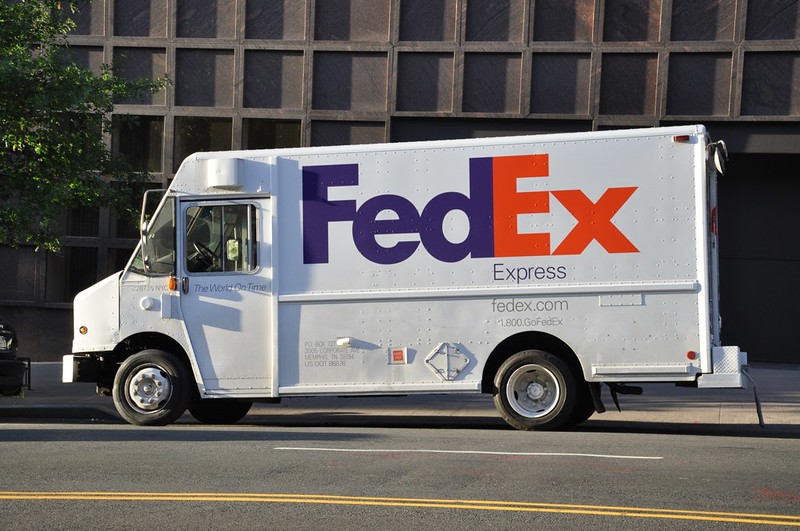
Understanding FedEx Trip Buddy
FedEx Trip Buddy is a mobile application that allows users to track their shipments on the go. The app is available for both iOS and Android devices, making it accessible to a wide range of users.
Users can easily track their shipments by entering their tracking number or scanning the barcode on their shipping label. The app provides real-time updates on the status of the shipment, including the estimated delivery date and time.
One of the key features of FedEx Trip Buddy is the ability to receive push notifications when there is a change in the status of the shipment. This feature allows users to stay up-to-date on the progress of their shipment without having to constantly check the app.
The app also includes a number of other useful features, such as the ability to save frequently used tracking numbers for quick access, and the ability to view a shipment’s full tracking history.
Overall, FedEx Trip Buddy is a useful tool for anyone who needs to track their shipments on the go. The app is easy to use and provides real-time updates, making it a reliable way to stay informed about the status of your shipments.
Tracking and Notifications
FedEx Trip Buddy provides a comprehensive tracking and notification system that keeps users informed about the status of their shipments. The system is designed to provide real-time updates and alerts to ensure that users have the most up-to-date information about their shipments.
Real Time Tracking
The real-time tracking feature allows users to track their shipments from start to finish. Users can enter their tracking number on the FedEx website and get real-time updates on the status of their shipment. The system provides detailed information about the location of the package, the estimated delivery date, and any delays or issues that may arise during the shipping process.
Delivery Notifications
Delivery notifications are an important part of the FedEx Trip Buddy system. Users can set up alerts to receive notifications when their package is out for delivery, when it has been delivered, or when there are any delays or issues with the shipment. This feature ensures that users are always aware of the status of their package and can plan accordingly.
Push Notifications
Push notifications are another important feature of the FedEx Trip Buddy system. Users can receive push notifications on their mobile devices when there are updates to their shipment. This feature is particularly useful for users who are on the go and need to stay informed about the status of their package.
Overall, the tracking and notification system provided by FedEx Trip Buddy is a valuable tool for anyone who needs to track shipments and stay informed about their delivery status. With real-time tracking, delivery notifications, and push notifications, users can stay up-to-date on the status of their packages and plan accordingly.
Shipping and Deliveries
When it comes to shipping and deliveries, FedEx Trip Buddy offers a range of options to meet the diverse needs of its customers. Below are some of the key features of FedEx’s shipping and delivery services.
International Shipping
FedEx offers international shipping services to more than 220 countries and territories around the world. Whether you need to send a package to a customer overseas or receive a shipment from a supplier abroad, FedEx has you covered. With a variety of shipping options to choose from, including FedEx Express and FedEx Ground, you can find the right service to meet your needs.
Residential Delivery
FedEx also offers residential delivery services, ensuring that your packages are delivered directly to your doorstep. With FedEx Home Delivery, you can choose between delivery on a specific day or a specific time of day, making it easier to plan your schedule around your delivery.
FedEx Home Delivery
FedEx Home Delivery is a service that is designed specifically for residential customers. With this service, packages are delivered directly to your doorstep, ensuring that you receive your shipments in a timely and convenient manner. FedEx Home Delivery offers a range of delivery options, including delivery on a specific day or a specific time of day, making it easy to plan your schedule around your delivery.
Overall, FedEx’s shipping and delivery services offer a reliable and convenient way to send and receive packages. With a variety of options to choose from, you can find the right service to meet your needs, whether you’re shipping internationally or receiving packages at home.
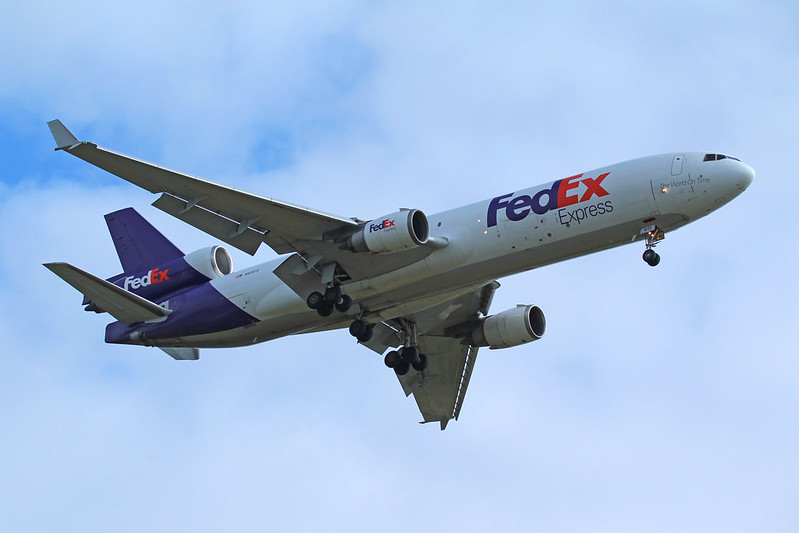
Using the FedEx Mobile App
The FedEx Mobile App is a convenient tool that allows users to track their shipments, schedule pickups, and access other FedEx services from their mobile devices. To get started with the app, users must download and install it on their devices, set up an account, and navigate the different features.
Download and Installation
The FedEx Mobile App is available for download on both the App Store and Google Play. Users can search for “FedEx Mobile” in either store and select the app with the FedEx logo to download it. Once the app is downloaded, users can open it and follow the prompts to complete the installation process.
Setting Up Account
To use the FedEx Mobile App, users must have a valid FedEx account. If they don’t have one, they can create an account within the app by providing their personal and business information. If they already have a FedEx account, they can sign in to the app using their user ID and password.
Navigating the App
The FedEx Mobile App has a user-friendly interface that allows users to easily navigate through different features. The main menu of the app includes options for tracking shipments, scheduling pickups, accessing shipping labels, and more. Users can also customize their settings within the app to receive notifications about their shipments and manage their account information.
Overall, the FedEx Mobile App is a useful tool for anyone who needs to track their shipments or access FedEx services on the go. With its easy-to-use interface and convenient features, the app is a valuable addition to any mobile device.
Benefits of FedEx Trip Buddy
FedEx Trip Buddy is a valuable tool that can help businesses and individuals streamline their shipping process. Here are some of the benefits that come with using FedEx Trip Buddy:
My FedEx Rewards
One of the main benefits of using FedEx Trip Buddy is that it allows users to earn My FedEx Rewards points. These points can be redeemed for discounts on future shipments, gift cards, and other rewards. The more shipments you make using FedEx, the more rewards points you can earn.
Picture Proof of Delivery
Another benefit of using FedEx Trip Buddy is that it provides users with picture proof of delivery. This feature ensures that the recipient has received the package and can be especially useful for businesses that need to provide proof of delivery to their customers.
Vacation Hold
FedEx Trip Buddy also allows users to put their shipments on hold when they are on vacation or out of town. This feature can be especially useful for individuals who frequently travel or for businesses that need to temporarily suspend their shipping operations.
Overall, the benefits of using FedEx Trip Buddy are clear. With features like My FedEx Rewards, picture proof of delivery, and vacation hold, users can save time, earn rewards, and streamline their shipping process.
Managing Shipments
FedEx Trip Buddy makes it easy to manage shipments with a variety of tools and features. Here are some of the key ways to manage shipments using the platform:
Creating Shipping Labels
One of the most important features of FedEx Trip Buddy is the ability to create shipping labels quickly and easily. Users can create labels for both domestic and international shipments, and can choose from a variety of shipping options and delivery speeds. The platform also allows users to print labels directly from their computer or mobile device, making it easy to get shipments out the door quickly.
Order History
Another useful feature of FedEx Trip Buddy is the ability to track and manage order history. Users can view all of their past shipments and orders in one place, making it easy to keep track of important information like tracking numbers, delivery dates, and more. This feature can be especially helpful for businesses that need to keep detailed records of their shipping activity.
Pick Up and Delivery Options
FedEx Trip Buddy also offers a variety of pickup and delivery options, making it easy to get shipments where they need to go. Users can schedule pickups for their shipments at a time and location that works best for them, and can also choose from a variety of delivery options like same-day, next-day, and more. This flexibility can be especially helpful for businesses that need to get shipments out quickly or on a tight schedule.
Overall, FedEx Trip Buddy is a powerful tool for managing shipments and getting them where they need to go. With features like easy label creation, order history tracking, and flexible pickup and delivery options, it’s a great choice for businesses of all sizes.
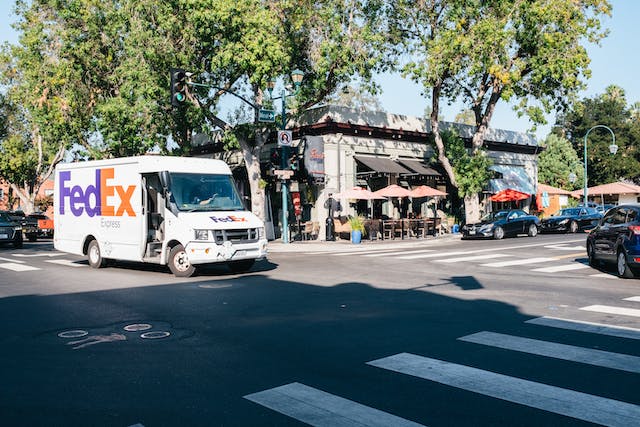
Support and Assistance
FedEx Trip Buddy provides excellent support and assistance to its users. Whether you need help with tracking your shipment or have any other queries, you can always count on FedEx’s support team.
Chat Support
One of the most convenient ways to get help is through the chat support feature. You can chat with a FedEx representative online and get your questions answered quickly. The chat support feature is available 24/7, so you can get help whenever you need it.
FedEx Delivery Manager
FedEx Delivery Manager is a powerful tool that allows you to customize your delivery preferences. You can choose the delivery time, location, and even request a hold at a FedEx location. This feature is especially useful if you’re not going to be home to receive your package.
My FedEx
My FedEx is a personalized dashboard that allows you to manage all your shipments in one place. You can track your packages, schedule pickups, and create shipping labels. My FedEx also provides access to exclusive offers and discounts.
In conclusion, FedEx Trip Buddy provides excellent support and assistance to its users. The chat support feature, FedEx Delivery Manager, and My FedEx are just a few examples of the tools available to help you manage your shipments. With FedEx’s support team, you can rest assured that your packages are in good hands.
Account Management
FedEx Trip Buddy offers a comprehensive account management system that allows users to manage their account information in one place. This section covers the various aspects of account management, including business account, address book, and payment options.
Business Account
Users can easily create and manage their business account through the FedEx Trip Buddy platform. This feature allows users to enjoy exclusive benefits such as discounted rates, simplified billing, and enhanced tracking capabilities. Users can also customize their account settings to suit their specific business needs.
Address Book
The address book feature in FedEx Trip Buddy allows users to save and manage their frequently used addresses. This feature simplifies the shipping process by allowing users to quickly select the desired address from their saved list. Users can also add, edit, or delete addresses as needed.
Payment Options
FedEx Trip Buddy offers a variety of payment options to suit the needs of different users. Users can choose to pay by credit card, PayPal, or through their FedEx account. The platform also allows users to save their payment information for quick and easy checkout.
In conclusion, FedEx Trip Buddy’s account management system provides users with a simple and effective way to manage their account information. With features such as business account, address book, and payment options, users can streamline their shipping process and focus on growing their business.
Legal and Copyright
FedEx Trip Buddy is a trademark of FedEx Corporation, a global courier delivery services company. The use of the name and logo of FedEx Trip Buddy is subject to strict legal regulations. Any unauthorized use of the name or logo of FedEx Trip Buddy is prohibited and may result in legal action.
All content, including text, images, and logos, on the FedEx Trip Buddy website is protected by copyright laws. The content on the website may not be reproduced, distributed, or transmitted in any form or by any means, including photocopying, recording, or other electronic or mechanical methods, without the prior written permission of FedEx Corporation.
FedEx Corporation reserves the right to modify, suspend, or discontinue the FedEx Trip Buddy service at any time without notice. The company also reserves the right to modify the terms and conditions of the service without prior notice.
Users of the FedEx Trip Buddy service should carefully read and understand the terms and conditions of the service before using it. The terms and conditions outline the user’s rights and responsibilities and provide important information about the service.
In conclusion, the use of FedEx Trip Buddy is subject to strict legal regulations, and users should carefully read and understand the terms and conditions of the service before using it. Any unauthorized use of the name or logo of FedEx Trip Buddy is prohibited and may result in legal action.
Frequently Asked Questions
How do I use the FedEx Trip Toolbox?
To use the FedEx Trip Toolbox, you need to create a FedEx account. Once you have an account, log in to the FedEx website and select the “Trip Tools” option. From there, you can access the Trip Toolbox and use it to plan your trip, get real-time updates on your shipment, and more.
What is the FedEx Purple ID login?
The FedEx Purple ID login is a secure login system that allows you to access your FedEx account and use all of the features of the Trip Toolbox. You can create a Purple ID by visiting the FedEx website and following the instructions on the login page.
What is the Trip Buddy feature on the FedEx app?
The Trip Buddy feature on the FedEx app is a tool that allows you to track your shipments, get real-time updates on their status, and manage your shipments from your mobile device. You can download the FedEx app from the App Store or Google Play Store.
How do I track my FedEx package?
To track your FedEx package, visit the FedEx website and enter your tracking number in the “Track Your Shipment” field. You can also use the Trip Buddy feature on the FedEx app to track your package from your mobile device.
What is the price of the Tripbuddy app?
The Tripbuddy app is free to download and use. However, there may be additional fees for certain features, such as expedited shipping or international shipping.
Can I scan a FedEx label with my phone?
Yes, you can scan a FedEx label with your phone using the Trip Buddy feature on the FedEx app. Simply open the app, select the “Scan a Label” option, and follow the instructions to scan your label.
Bulkhead Seat: The Pros and Cons of Choosing this Airplane Seating Option
Bulkhead seats are a popular choice among air travelers who want to enjoy a little extra legroom and comfort during their flight. These seats are located at the front of each cabin section, directly behind a divider or bulkhead, and are often considered prime real estate due to their spaciousness and proximity to the cabin crew. While bulkhead seats can be a great option for many passengers, they also come with their own set of advantages and disadvantages that should be carefully considered before booking.
Understanding Bulkhead Seats
Bulkhead seats are typically located at the front of each cabin section, directly behind a divider or bulkhead. They are often considered prime real estate due to their spaciousness and proximity to the cabin crew. These seats are also generally located near the lavatories and galley, which can be a convenience or a drawback depending on the passenger’s needs.
Airlines and Bulkhead Seats
Most airlines offer bulkhead seats as an option for passengers who want to enjoy a little extra legroom and comfort during their flight. However, the availability of these seats can vary depending on the airline, the aircraft type, and the route. Some airlines charge extra fees for bulkhead seats, while others offer them as a complimentary upgrade for elite frequent flyers or passengers with special needs.
Understanding Bulkhead Seats
Bulkhead seats are the seats located behind a physical wall separating different sections of the plane. These seats are often considered premium seating because they offer more legroom and space for passengers to stretch out.
The bulkhead seats are often located at the front of the plane, and they are usually reserved for passengers with disabilities, families with infants, or passengers who have paid extra for the privilege of sitting there.
One of the main advantages of bulkhead seating is the extra legroom. Since there is no seat in front of the bulkhead seat, passengers have more space to stretch out their legs. This can be especially important for taller passengers who may find regular seats uncomfortable.
Another benefit of bulkhead seating is that it is often quieter than other parts of the plane. This is because there are no seats in front of the bulkhead, which means that there are fewer people moving around and making noise.
However, there are also some drawbacks to bulkhead seating. For example, passengers in these seats may not have access to under-seat storage, which means that they will need to store their carry-on luggage in the overhead compartments. Additionally, some bulkhead seats may have limited recline, which can make it difficult to get comfortable during a long flight.
Overall, bulkhead seats can offer a more comfortable flying experience for passengers who are willing to pay extra for the privilege. However, it is important to weigh the pros and cons before choosing to sit in one of these seats.

Airlines and Bulkhead Seats
Bulkhead seats are highly sought after by many airline passengers. These seats are located at the front of the cabin, directly behind the bulkhead wall, which separates the cabin from the cockpit and/or galley area. They offer additional legroom and space, making them a popular choice for many travelers.
Many airlines offer bulkhead seats on their flights. United Airlines, for example, offers bulkhead seats on their Airbus A319-100, Airbus A320-200, Boeing 737-700, Boeing 737-800, Boeing 737-900, Boeing 737 MAX 8, Boeing 737 MAX 9, Boeing 757-200, Boeing 757-300, Boeing 767-300ER, Boeing 767-400ER, Boeing 777-200, Boeing 777-200ER, Boeing 777-300ER, Boeing 787-8, and Boeing 787-9 aircraft.
Other airlines, such as Delta and American Airlines, also offer bulkhead seats on select aircraft in their fleet. The type of aircraft and the number of bulkhead seats available may vary depending on the airline.
It is important to note that while bulkhead seats offer additional legroom and space, they may not always be the best option for all passengers. Some bulkhead seats do not have under-seat storage, which can be inconvenient for travelers who need to access their belongings during the flight. Additionally, bulkhead seats may be located near the lavatories or galley area, which can result in increased noise and foot traffic.
Overall, bulkhead seats are a popular choice for many airline passengers, and many airlines offer them on select aircraft in their fleet.
Bulkhead Seat Layouts
Bulkhead seats are highly sought after by travelers for their added legroom and proximity to the front of the aircraft. These seats are located behind a physical barrier, separating them from the rest of the cabin. They are often found in first class, business class, and premium economy, but can also be available in coach.
The layout of bulkhead seats can vary depending on the airline and class of service. In first class and business class, bulkhead seats are typically individual suites with a door for added privacy. In premium economy and coach, bulkhead seats are often arranged in a 2-3-2 or 3-3-3 configuration.
For example, in United Airlines’ Polaris business class, the bulkhead seats are individual suites with a door for added privacy. These seats are arranged in a 1-2-1 configuration, with the seat and footrest converting into a fully flat bed. In contrast, in United Airlines’ economy class, the bulkhead seats are arranged in a 3-3-3 configuration, with extra legroom due to the lack of seats in front of them.
When selecting a bulkhead seat, it’s important to note that some seats may have restricted legroom due to the placement of the bulkhead wall or the location of the lavatory. It’s also important to note that some bulkhead seats may not have under-seat storage due to the placement of the entertainment system or other equipment.
Overall, bulkhead seats can provide added comfort for travelers, but it’s important to research the specific layout and restrictions of these seats before selecting them.
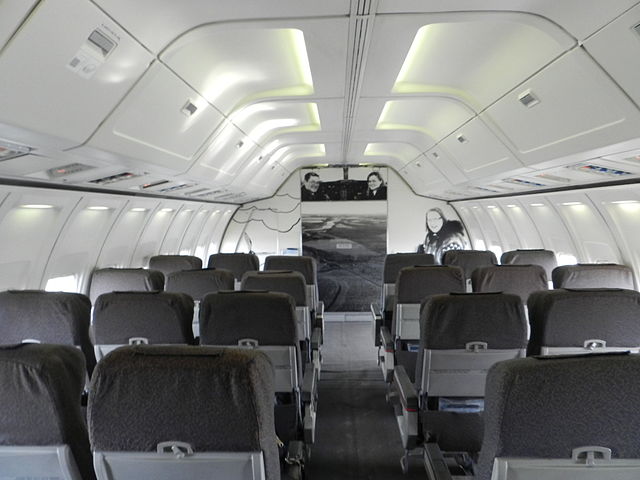
Pros and Cons of Bulkhead Seats
Bulkhead seats are often coveted by travelers for their extra legroom and other perks. However, there are also some drawbacks to these seats that travelers should be aware of before choosing them. Here are some pros and cons of bulkhead seats:
Pros
- Extra legroom: Bulkhead seats are located at the front of the cabin, which means that there is no seat in front of them. This provides extra legroom for the passenger, which can be especially beneficial on long flights.
- More space: The lack of a seat in front also means that there is more space for the passenger to stretch out and move around.
- Priority boarding: Many airlines offer priority boarding to passengers seated in bulkhead seats, which can be a time-saver.
- No reclining seats in front: Since there is no seat in front, there is no possibility of having the seat in front recline into the passenger’s space.
Cons
- Limited legroom during takeoff and landing: While bulkhead seats offer extra legroom during the flight, passengers may find that they have limited legroom during takeoff and landing due to the proximity of the bulkhead wall.
- Limited storage space: Bulkhead seats often have limited storage space since there is no seat in front to store items under.
- Noise and disturbance: Passengers seated in bulkhead seats may experience more noise and disturbance from the galley and lavatories located nearby.
- Limited privacy: Since bulkhead seats are located at the front of the cabin, passengers may feel that they have less privacy than those seated further back.
Overall, bulkhead seats can be a good choice for passengers who value extra legroom and space. However, they do come with some drawbacks that travelers should consider before selecting them.
Bulkhead Seats and In-Flight Amenities
Bulkhead seats are the first row of seats in an aircraft cabin, typically located behind a physical barrier such as a wall or curtain. These seats are highly sought after by many passengers due to their additional legroom. However, there are other in-flight amenities that come with bulkhead seats that are worth considering.
One of the main benefits of bulkhead seats is the extra storage space. As there is no seat in front of the passenger, there is usually a larger tray table that folds down from the armrest. This provides ample space for laptops, books, and other personal items. Additionally, there is often more overhead compartment space available for carry-on luggage, as well as under-seat storage.
Another advantage of bulkhead seats is the potential for better in-flight entertainment. Some airlines have installed larger display screens in the bulkhead seats, which can provide a better viewing experience. Additionally, the galley is often located in front of the bulkhead seats, which can mean quicker access to food and drinks.
However, it is important to note that not all bulkhead seats are created equal. Some bulkhead seats may have limited legroom due to the presence of an entertainment box or other equipment. Additionally, some bulkhead seats may not recline fully, which can be uncomfortable for longer flights.
Overall, bulkhead seats can provide a more comfortable and convenient flying experience for many passengers. However, it is important to weigh the pros and cons of each specific seat before making a decision.
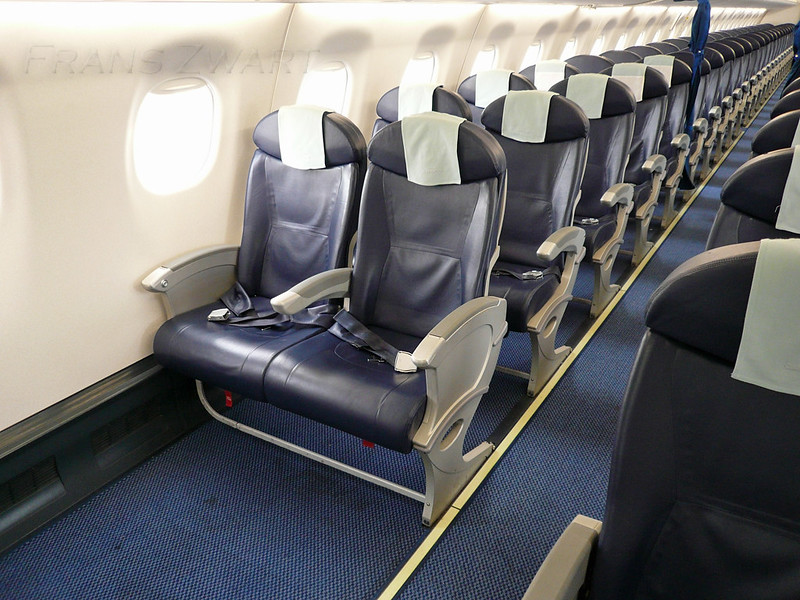
Boarding and Deplaning with Bulkhead Seats
Bulkhead seats are located at the front of the plane, behind the cockpit and in front of the first row of seats. These seats offer more legroom and are often preferred by passengers who are tall or have mobility issues. However, boarding and deplaning with bulkhead seats can be different from other seats on the plane.
When boarding, passengers with bulkhead seats typically have priority boarding. This allows them to board the plane before other passengers and get settled into their seats before the rush. However, it is important to note that priority boarding may vary depending on the airline and the type of ticket purchased.
Deplaning with bulkhead seats can also be different. Passengers with bulkhead seats are usually the first to exit the plane, as they are located at the front of the plane. This can be an advantage for those who need to make a tight connection or want to get off the plane quickly.
It is important to note that not all bulkhead seats are created equal. Some bulkhead seats may have limited recline or may not have under-seat storage. It is best to research the specific airline and aircraft to determine the best bulkhead seat for your needs.
In summary, boarding and deplaning with bulkhead seats can offer advantages for passengers, including priority boarding and quick exit from the plane. However, it is important to research the specific airline and aircraft to determine the best bulkhead seat for your needs.
Pricing and Fees for Bulkhead Seats
Bulkhead seats are highly sought after by many travelers due to the extra legroom they provide. However, they often come with a higher price tag than regular seats. The pricing for bulkhead seats can vary depending on the airline, route, and demand.
Some airlines charge a flat fee for bulkhead seats, while others may charge a percentage of the ticket price. The fees for bulkhead seats can range from $20 to $200 or more per flight segment. It is important to note that these fees are in addition to the cost of the ticket itself.
Some airlines offer publicly available offers for upgrading to bulkhead seats, while others may only offer them to frequent flyers or those with certain credit cards. It is important to check with the airline to see what options are available and what the requirements are.
It is also worth noting that some airlines may offer bulkhead seats as part of a package deal or upgrade offer, which may include other perks such as priority boarding or extra baggage allowance.
While bulkhead seats can be expensive, they can also be a worthwhile investment for those who value the extra legroom and comfort. It is important to weigh the cost against the benefits and determine if it is worth it for each individual traveler.
Overall, the pricing and fees for bulkhead seats can vary greatly depending on the airline and route. It is important to research and compare options to find the best deal. Additionally, it is important to be aware of any affiliate commission or other incentives that may be involved in the sale of bulkhead seats.
Bulkhead Seats during Long-Haul Flights
Bulkhead seats are highly sought after by passengers who want extra legroom during long-haul flights. These seats are located in the first row of a cabin section, and are separated from the rest of the seats by a physical barrier known as a bulkhead.
Passengers who choose these seats can enjoy a more comfortable flight due to the extra space available. However, it is important to note that bulkhead seats come with their own set of drawbacks. For example, passengers in these seats may not have access to an under-seat storage area, which means that they will have to keep all of their belongings in the overhead bins.
Another disadvantage of bulkhead seats is that they may not recline as much as other seats, which can be uncomfortable during a long flight. Additionally, passengers seated in bulkhead seats may be more susceptible to noise and disturbances from the galley area or lavatories due to their proximity to these areas.
Despite these drawbacks, bulkhead seats are still a popular choice for many passengers on long-haul and international flights. Airlines often charge extra for these seats, so passengers should weigh the benefits and drawbacks carefully before making a decision.
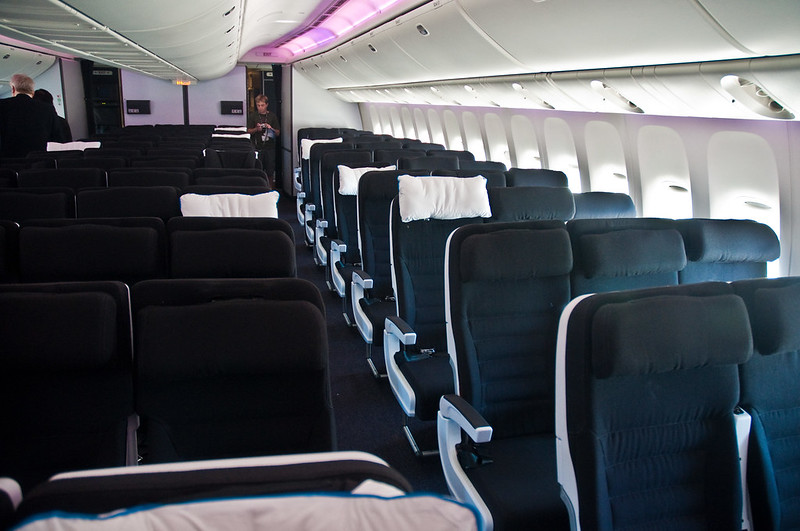
Bulkhead Seats and Travel Destinations
Bulkhead seats are a popular choice for many travelers, especially those who are looking for extra legroom and more space to stretch out during long flights. These seats are located in the front row of the cabin, and they offer a variety of benefits that can make your travel experience more comfortable and enjoyable.
If you are planning a trip to Mexico or Chicago, you may want to consider booking a bulkhead seat for your flight. These destinations are popular among travelers, and the extra space and comfort of a bulkhead seat can make all the difference during a long flight.
In Mexico, many travelers choose to visit popular destinations like Cancun, Puerto Vallarta, and Cabo San Lucas. These destinations offer beautiful beaches, vibrant nightlife, and a variety of cultural attractions. If you are planning a trip to Mexico, a bulkhead seat can help you arrive at your destination feeling refreshed and relaxed.
Chicago is another popular destination for travelers. This city is known for its stunning architecture, world-class museums, and delicious food. Whether you are visiting Chicago for business or pleasure, a bulkhead seat can help you arrive at your destination feeling ready to explore everything this city has to offer.
Overall, if you are looking for a way to make your next flight more comfortable and enjoyable, a bulkhead seat may be the perfect choice for you. With extra legroom and more space to stretch out, you can arrive at your destination feeling refreshed and ready to explore all that your destination has to offer.
Bulkhead Seats and Airline Programs
Bulkhead seats are highly sought after by many airline passengers. These seats are located in the first row of a cabin and offer additional legroom due to the absence of seats in front. However, not all airlines offer bulkhead seats as part of their standard seating arrangements.
For passengers who frequently travel on a particular airline, there may be opportunities to access bulkhead seats through airline programs. These programs can include loyalty programs, status tiers, and other benefits that can provide access to preferred seating arrangements.
For example, frequent flyers who achieve elite status with an airline may be granted access to bulkhead seats as a perk of their status. These passengers may also have the ability to select bulkhead seats in advance of their flight, giving them a better chance of securing these highly coveted seats.
It is important to note that access to bulkhead seats through airline programs is not guaranteed. Availability of these seats can vary depending on the airline, flight route, and other factors. Additionally, some airlines may charge an additional fee for access to bulkhead seats, even for passengers with elite status.
Passengers who are interested in accessing bulkhead seats through airline programs should research the specific policies and benefits of their preferred airline. It is also important to understand the requirements for achieving elite status and other program benefits that may be available.
Overall, while bulkhead seats can offer a more comfortable flying experience, access to these seats through airline programs may require additional effort and research on the part of the passenger.
Choosing Bulkhead Seats: A Guide
Bulkhead seats are the seats located immediately behind a physical barrier, such as a wall or curtain, that separates a cabin section from another part of the aircraft. These seats offer several advantages, including extra legroom, no reclining seat in front, and easy access to the aisle. However, not all bulkhead seats are created equal, and choosing the right one can make a big difference in your flying experience.
When selecting a bulkhead seat, it is important to consider the following factors:
- SeatGuru: SeatGuru is a website that provides detailed information about airplane seats, including seat pitch, width, and recline. It also offers seat maps that show the location of bulkhead seats, as well as other amenities such as lavatories and galleys. Checking SeatGuru before selecting a bulkhead seat can help you choose the best one for your needs.
- Aisle Access: If you value easy access to the aisle, choose a bulkhead seat that is located near the aisle. This will allow you to get up and move around the cabin without disturbing other passengers.
- Aisle Seat: If you prefer an aisle seat, choose a bulkhead seat that is located next to the aisle. This will give you more room to stretch your legs and allow you to exit the row more easily.
- Exit Row: Some airlines offer bulkhead seats that are also located in the exit row. These seats offer even more legroom and are ideal for tall passengers. However, they also come with additional responsibilities, such as assisting with emergency evacuations.
- Window: If you prefer a window seat, choose a bulkhead seat that is located next to the window. This will give you a great view of the sky and the ground below.
In summary, choosing the right bulkhead seat can make a big difference in your flying experience. By considering factors such as SeatGuru, aisle access, aisle seat, exit row, and window, you can select the best bulkhead seat for your needs.
Bulkhead Seats and Special Considerations
Bulkhead seats are often considered the most desirable seats on an airplane due to the extra legroom they provide. These seats are located at the front of each cabin section, and have a wall or curtain separating them from the rest of the cabin. However, there are some special considerations to keep in mind when choosing a bulkhead seat.
For parents traveling with babies, bulkhead seats can be a good option because they often have a bassinet attachment available. This allows parents to have their hands free during the flight while their baby sleeps comfortably. However, it is important to note that not all airlines offer this service, so it is best to check with the airline before booking a bulkhead seat for this purpose.
Another consideration is the footwell cutouts in bulkhead seats. While these cutouts provide extra legroom, they can also be a tripping hazard for flight attendants and passengers. It is important to keep these areas clear during the flight, and to avoid storing any luggage or personal items in this space.
Bulkhead seats are often separated from the rest of the cabin by a curtain, which can provide some privacy. However, it is important to note that this curtain is not soundproof, and noise from the galley or lavatory can still be heard. Additionally, the curtain may be opened during the flight for safety reasons, so passengers should be prepared for this possibility.
Finally, it is important to note that bulkhead seats often have limited storage space for luggage. Passengers in these seats may need to store their bags in overhead bins further back in the cabin, which can be inconvenient. However, some airlines provide additional storage options for passengers in bulkhead seats, so it is best to check with the airline before booking.
Overall, bulkhead seats can provide a comfortable flying experience for passengers who value extra legroom. However, it is important to consider the special considerations outlined above before choosing a bulkhead seat for your next flight.
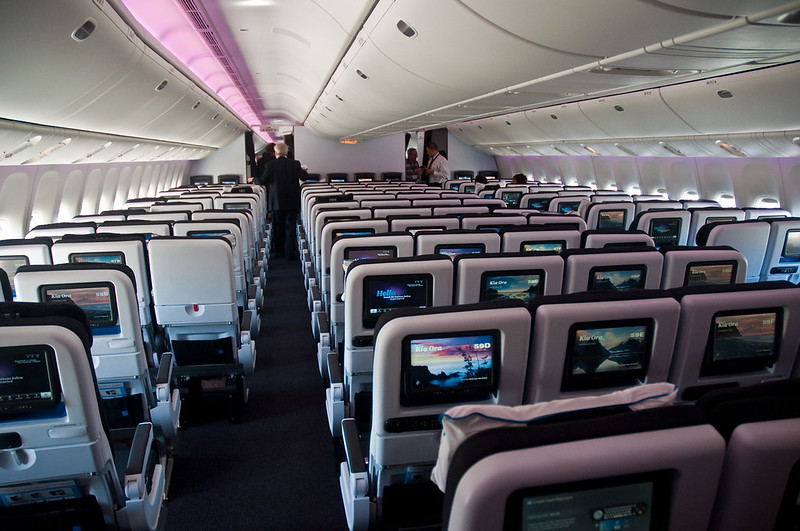
Bulkhead Seats in the Context of Pandemic
Bulkhead seats, which are located in the front row of a cabin, are often considered the most desirable seats on a plane. They offer more legroom and no one reclining into your personal space. However, in the context of pandemic, these seats may come with some drawbacks.
Firstly, bulkhead seats are often located near the lavatories and galleys, which are high-traffic areas. This increases the likelihood of coming into contact with other passengers and crew members, potentially increasing the risk of infection.
Secondly, some airlines have been using bulkhead seats as a location for in-flight medical equipment or as a quarantine area for passengers who may be showing symptoms of illness. This means that passengers seated in bulkhead seats may be more likely to be exposed to sick passengers.
On the other hand, some airlines have implemented additional measures to minimize the risk of infection for passengers seated in bulkhead seats. For example, some airlines have installed curtains or partitions to separate the bulkhead seats from the rest of the cabin.
Overall, while bulkhead seats may still offer some advantages in terms of comfort and legroom, passengers should be aware of the potential drawbacks in the context of pandemic. It is important to follow all recommended health and safety guidelines, such as wearing a mask and practicing good hygiene, regardless of where you are seated on the plane.
Bulkhead Seats and Other Travel Facilities
Bulkhead seats are highly coveted by many travelers due to their additional legroom and proximity to the front of the cabin. These seats are located immediately behind a physical barrier, such as a wall or curtain, and are typically found in the first row of each cabin section.
While bulkhead seats can provide a more comfortable flying experience, it’s important to note that not all bulkhead seats are created equal. Some may have limited recline or no under-seat storage due to the proximity to the cabin wall. It’s recommended that travelers research the specific aircraft and seat configuration before selecting a bulkhead seat.
In addition to bulkhead seats, many airlines offer other travel facilities to enhance the flying experience. JetBlue, for example, offers their Mint service, which includes lie-flat seats, personalized dining options, and access to exclusive lounges.
Hotels also play a significant role in the travel experience, offering amenities such as fitness centers, spas, and on-site restaurants. Some hotels, such as the Ritz-Carlton, even offer private club lounges for elite members.
When it comes to dining options, travelers can find a wide range of choices both in-flight and on the ground. Many airports offer a variety of restaurants and cafes, while some airlines offer gourmet dining options in their premium cabins.
Overall, the travel industry continues to evolve and offer new and innovative ways to enhance the travel experience. By researching and utilizing these facilities, travelers can make their journey more comfortable and enjoyable.
Frequently Asked Questions
Which airlines offer sleeping pods in business class?
Several airlines offer sleeping pods in business class, including Emirates, Qatar Airways, Etihad Airways, Singapore Airlines, and Cathay Pacific.
What are the pros and cons of choosing a bulkhead seat?
One advantage of choosing a bulkhead seat is that it typically has more legroom than other seats. However, bulkhead seats may not have under-seat storage, and passengers may not be able to recline their seats fully.
Do bulkhead seats come with TV screens?
Most airlines provide TV screens for bulkhead seats, but the location and size of the screen may vary depending on the aircraft type.
What is the difference between a bulkhead seat in business class and economy?
In business class, bulkhead seats may have more legroom and additional amenities such as a larger TV screen or a personal storage area. In economy, bulkhead seats may have more legroom but may not have under-seat storage.
Are bulkhead seats better than exit row seats?
Both bulkhead and exit row seats offer additional legroom, but exit row seats may have more restrictions on who can sit in them due to safety regulations. Bulkhead seats may also have more limited recline options.
Do bulkhead seats provide more legroom than other seats?
Yes, bulkhead seats typically have more legroom than other seats due to their location at the front of the cabin. However, some bulkhead seats may have limited recline options or no under-seat storage.


